Wondering what to eat in Denmark during your first trip to the Scandinavian country? Discover 25 must-try traditional Danish food favorites to sample in the country known for Hans Christian Andersen, Legos and Noma.
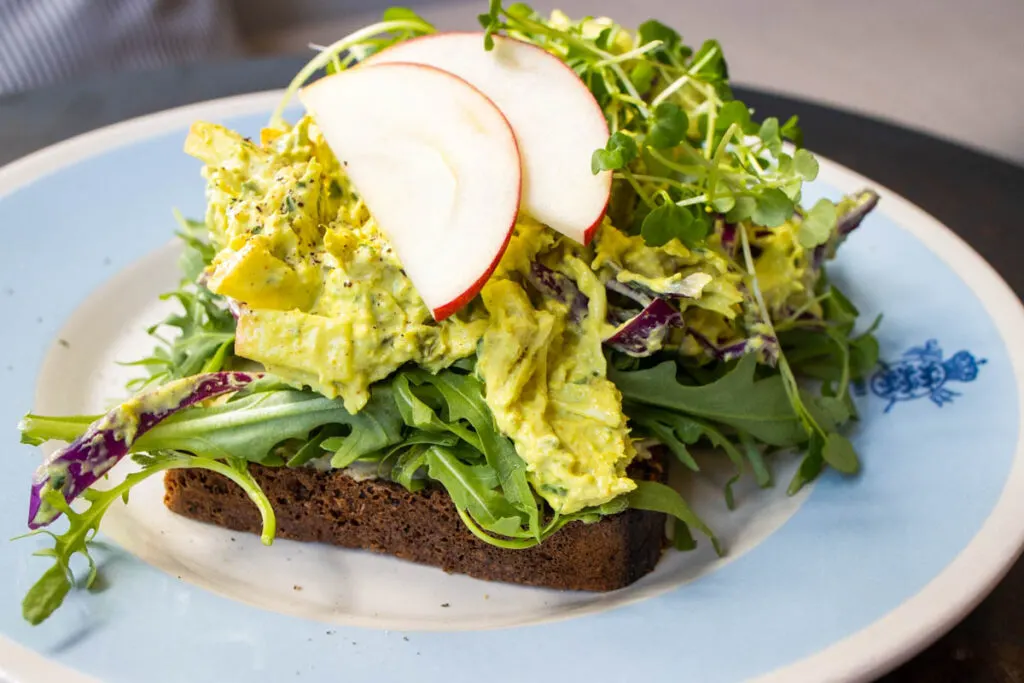
Are you familiar with Danish food? Don’t feel bad if you’re not. We were a bit naive about Danish food culture until we traveled to Denmark and spent a week diving into the Copenhagen food scene.
Prior to our trip, we knew about Copenhagen’s New Nordic food movement and the city’s world class reputation for baked goods. We arrived to the Danish capital with Noma reservations in hand and a list of bakeries to visit as long as our arms.
Check out our dinner at Noma if you’re curious about Noma’s Game & Forest menu.
However, we knew little about traditional Danish food beyond snail shaped pastries commonly called ‘danishes’ in America. It’s not that we weren’t interested in Scandinavia’s most exciting cuisine. Rather, unlike Italian and Chinese cuisines, Danish food isn’t on every other American street corner.
What Is Traditional Danish Food?
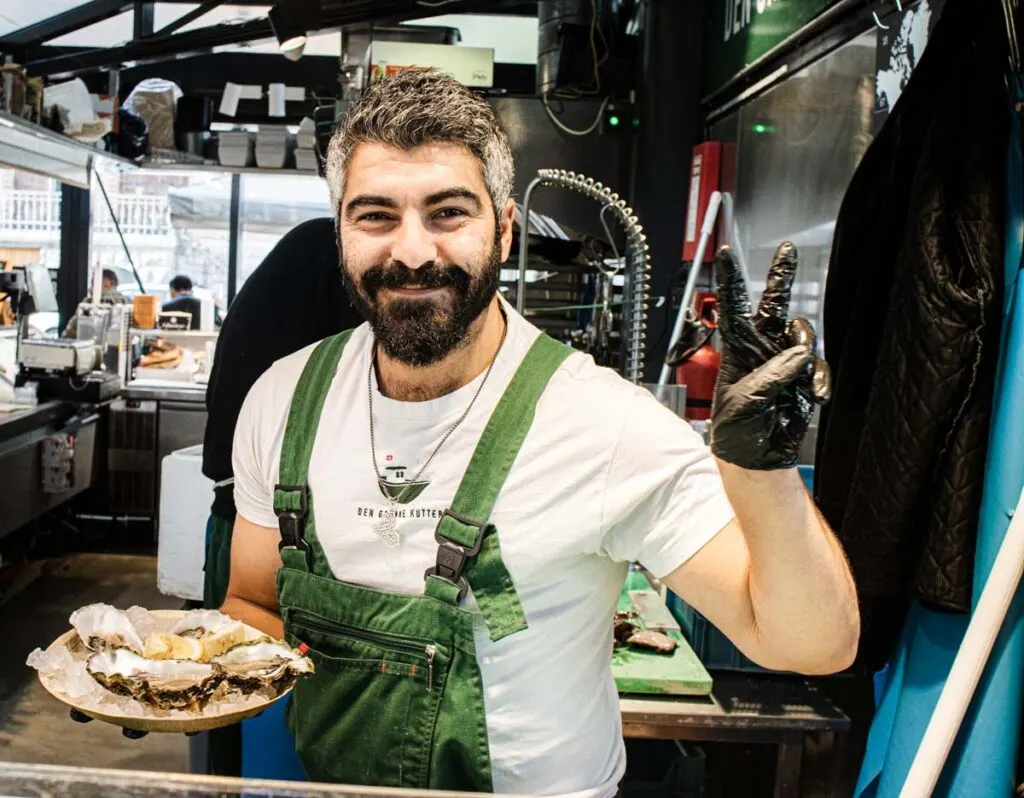
Denmark’s traditional food has a direct correlation to the country’s geography and climate. But these aren’t the sole elements that helped form Danish cuisine…
We’d be remiss if we didn’t recognize the Danish people themselves. Notable for both their strong work ethic as well as their commitment to hygge, a concept that encourages a cozy and comfortable lifestyle, Danes have directly influenced their country’s cuisine.
Fun Fact
The Danish diet is nothing new. Its roots date back centuries to Denmark’s Viking days.
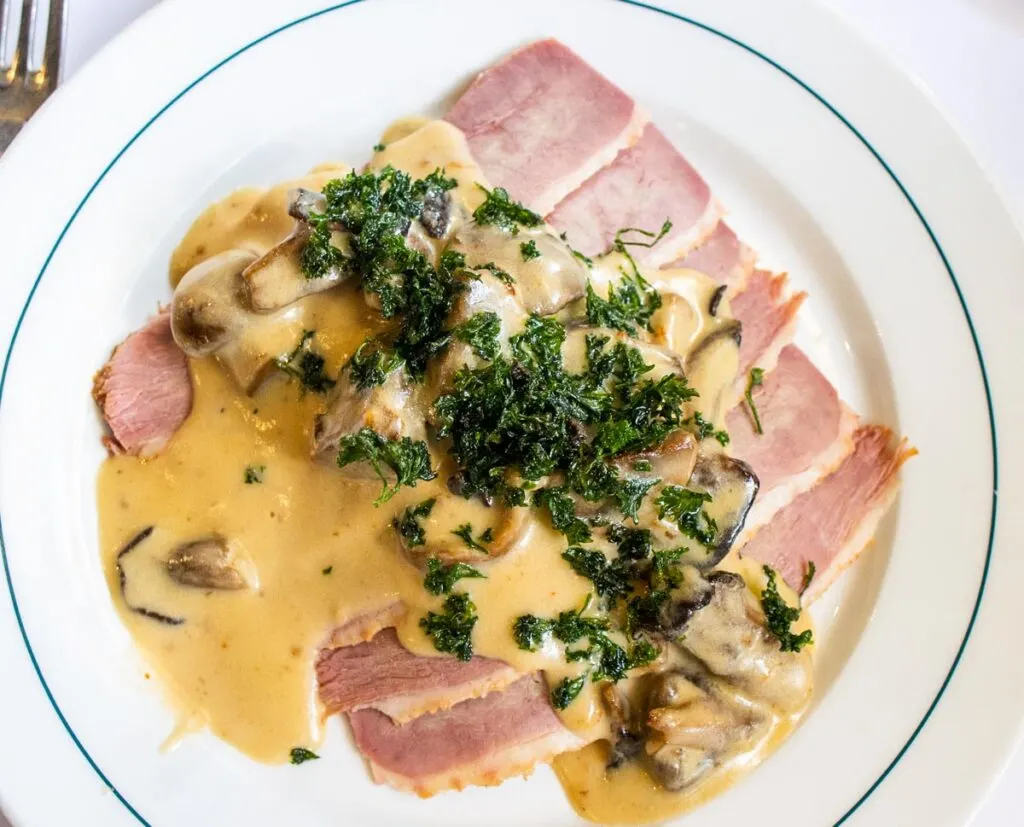
Located north of Germany and south of both Norway and Sweden, Denmark is Scandinavia’s most southern country. It’s flanked by both the Baltic and North Seas and has more than 400 islands.
Danish winters tend to be long and cold. Accordingly, Danes traditionally eat a preponderance of meat and boiled potatoes during the winter and a lot of fish and fresh berries during warmer months. Regardless of the season, locally sourced foods, both farmed and foraged, can be easily found in Denmark.
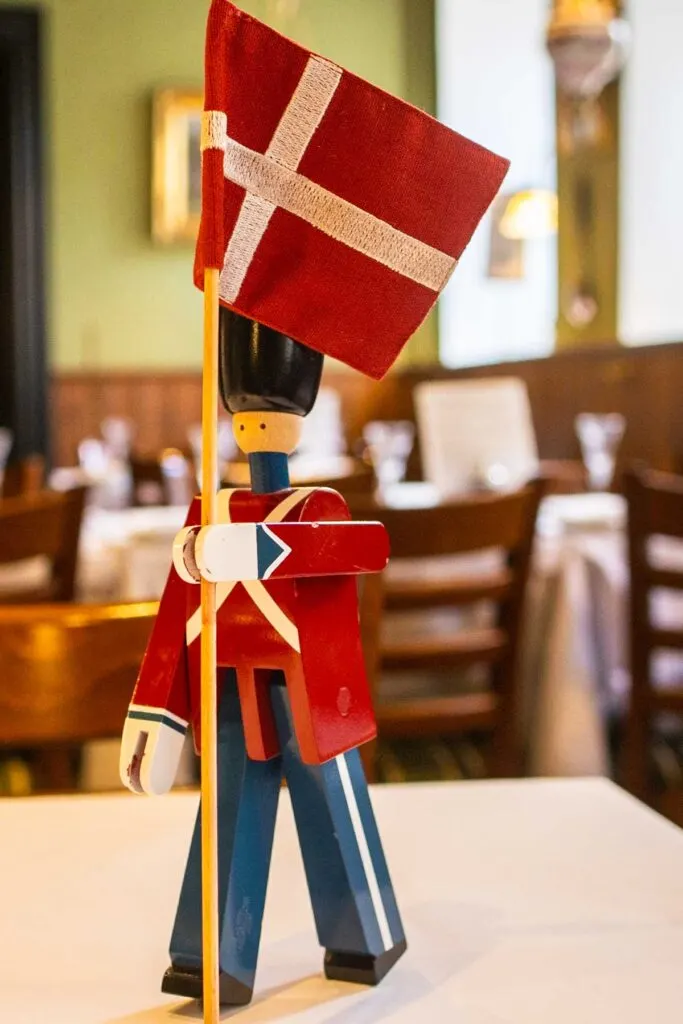
Don’t feel bad for the Danes…
Despite Denmark’s long, cold winters, Danes consistently rank as some of the happiest people in the world. We choose to believe that this happiness is partially due to the country’s plethora of desserts and pastries. Danish sweet treats certainly make us happy!
What to Eat in Denmark
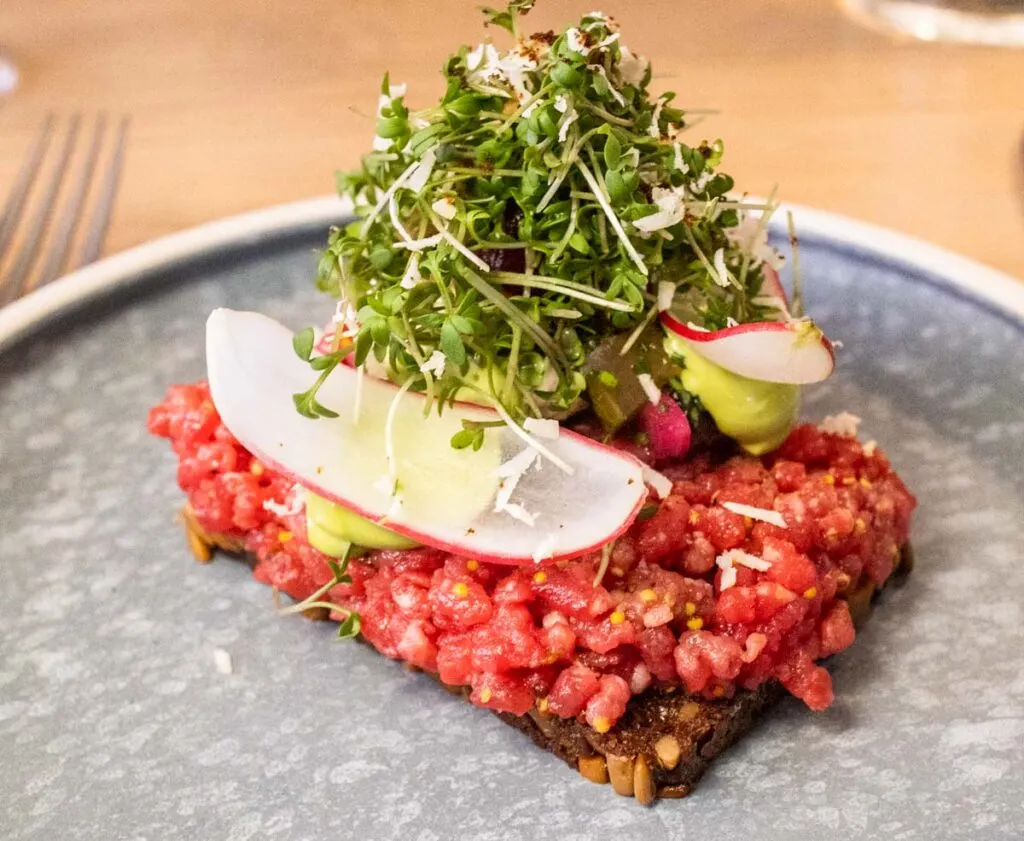
One week in Copenhagen transformed us from Danish food novices to Danish food fans. We now have more than two dozen Danish dishes and drinks that we’d happily fly back to Copenhagen to enjoy again. And that’s not even counting the city’s amazing restaurant scene!
In the future, maybe we’ll return to eat Danish Christmas food and drink Gloegg during a December visit. But, for now, we’ve placed our favorite Danish foods and drinks into this handy Denmark food guide which we’ve separated into the following categories for ease of use:
Traditional Danish Food
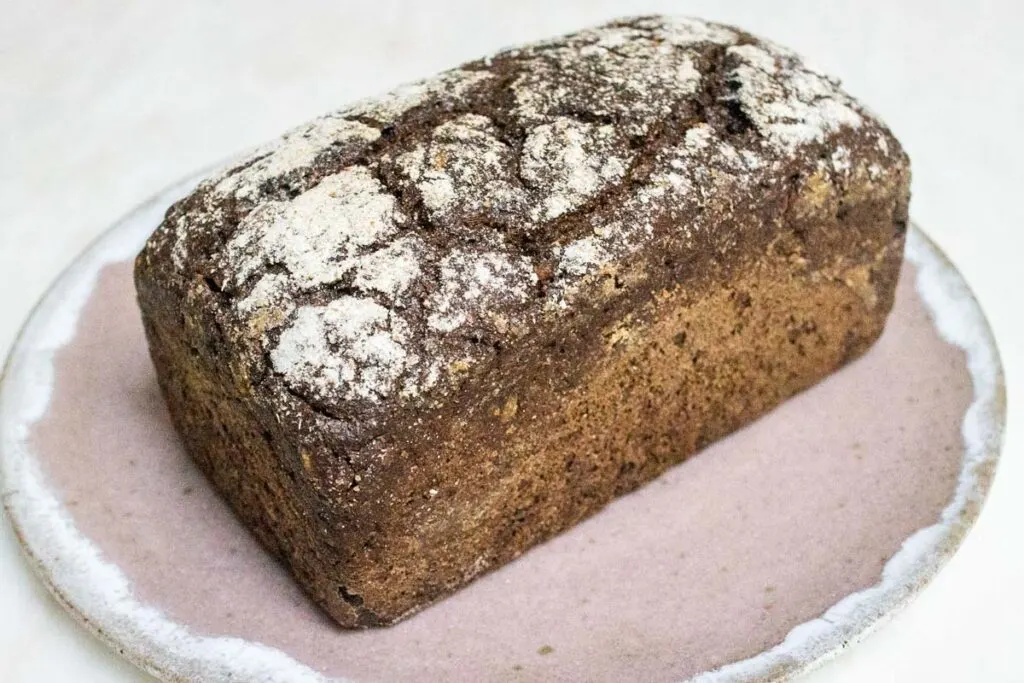
We specifically flew to Copenhagen to experience superfluous New Nordic Cuisine at Noma. However, we also wanted to enjoy as much traditional Danish cuisine as possible during our week-long visit. Some new-to-us Danish dishes, like the show stopping Stjerneskud we ate at Schønnemann, stand out as highlights of our Denmark food trip.
Read on to discover our picks for the 10 best traditional Danish foods plus two traditional Danish dishes on the top of our list to try when we return:
1. Smørrebrød (Sandwiches)
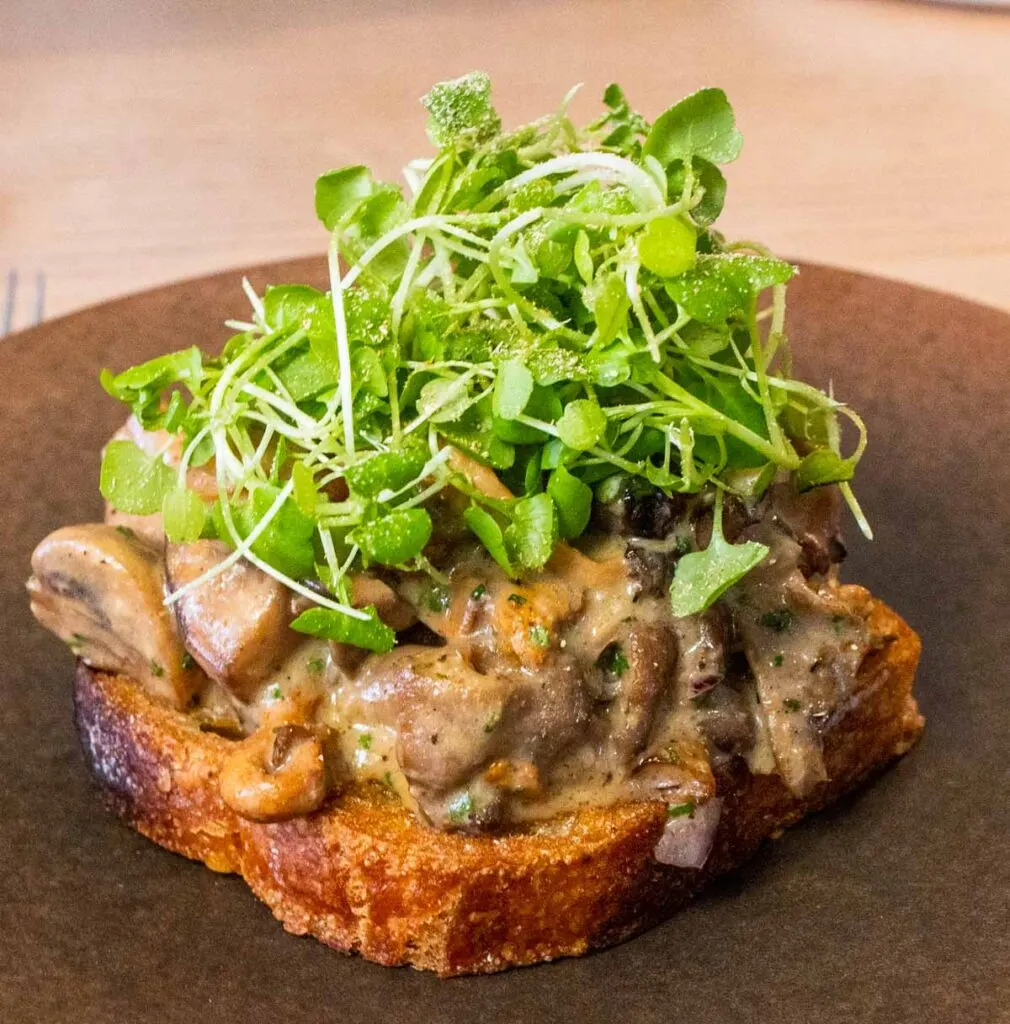
The idea of topping a slice of bread with a protein, some greens and cheese or sauce may sound simple. But Denmarks’s humble Smørrebrød has grown from a basic, nourishing, utilitarian, bread-based 19th century meal to a platform for modern day chef-driven creativity.
While one could hypothetically construct a simple Smørrebrødet with a little ham, cheese and lettuce, the Danes have taken their sandwich concept in new, exciting directions. Accordingly, Danish restaurants In bigger cities like Copenhagen and Aarhus offer endless Smørrebrød topping combinations in addition to traditional Smørrebrød options.
Discover our favorite Copenhagen restaurants.
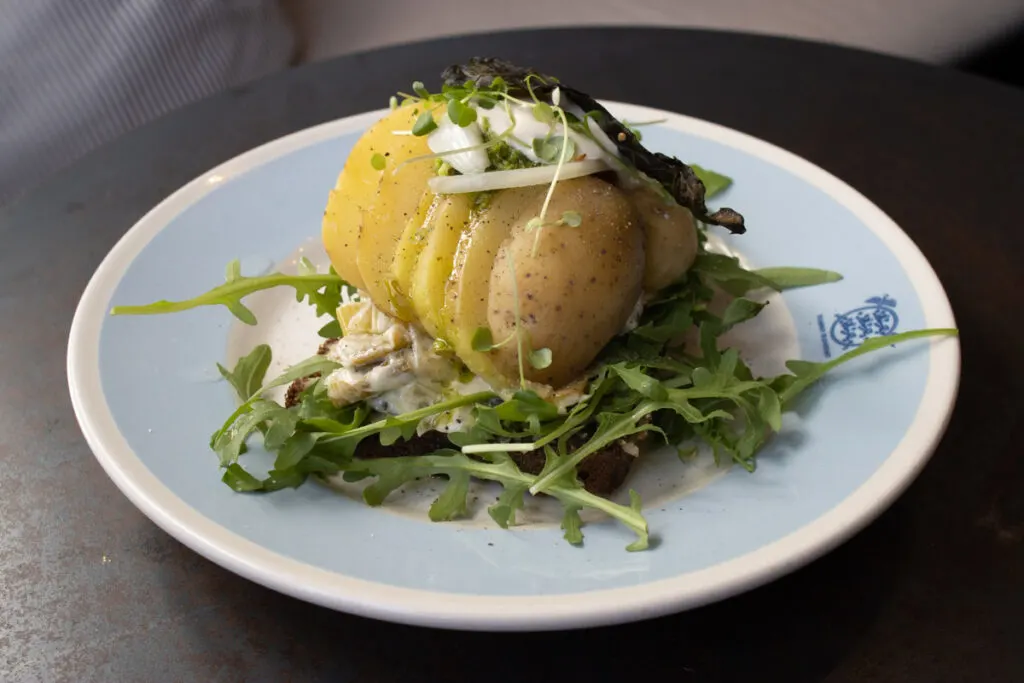
We started our personal Smørrebrød journey by eating a sandwich topped with grilled chicken and cooked potatoes and quickly tried another topped with egg salad and then another topped with traditional herring. However, we loved Copenhagen Chef Adam Aaman’s creative Smørrebrøds – one topped with dry aged beef tartare and another topped with chanterelle and oyster mushroom gravy – most of all.
Generally, the Danish like eating Smørrebrød on thinly sliced Rugbrød, a dark whole grain rye that provides a wholesome base for fresh, local ingredients. They also don’t like to mix proteins. Each element has its own place in the construction of the sandwich. There’s no muddling of flavors. There’s also a proper way to eat a Smørrebrød – with utensils and not hands. This half sandwich is a regal Danish institution but, most important, it’s a tasty meal.
Where We Ate Smørrebrød
Aamanns 1921, Schønnemann and Sonny
2. Stjerneskud (Shooting Stars)
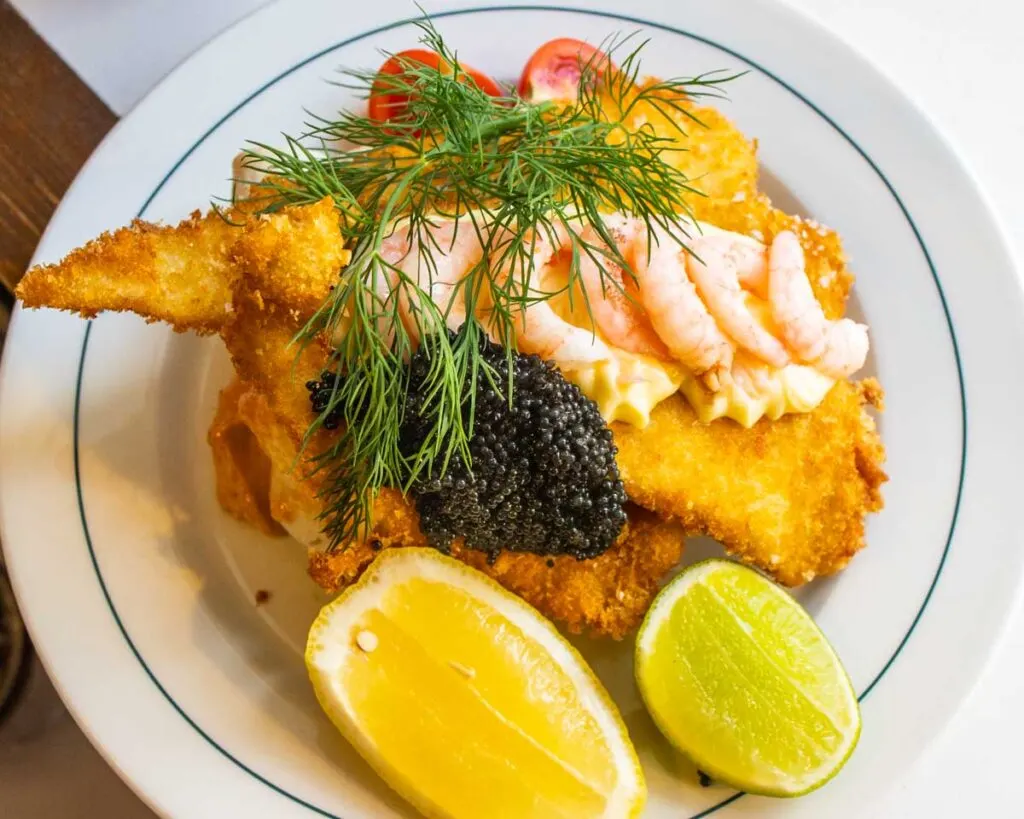
While the Stjerneskud is technically a Smørrebrød, this over-the-top dish is so special that it deserves its own category and a name as epic as its ingredient list. Since stjerneskud translates to shooting star, the Danes clearly agree with us in this regard.
Legend has it that the Stjerneskud debuted in the 1960s when a Russian cosmonaut visited Denmark which inspired the Stjerneskud’s name. While this legend may or may not be true, there’s no debate that the Stjerneskud is a party on a plate with an ingredient list that includes fried plaice (a flaky flat fish similar to flounder), fresh shrimp, remoulade sauce and a generous dollop of Danish caviar.
Where We Ate Stjerneskud
Schønnemann
3. Tarteletter (Tartlets)
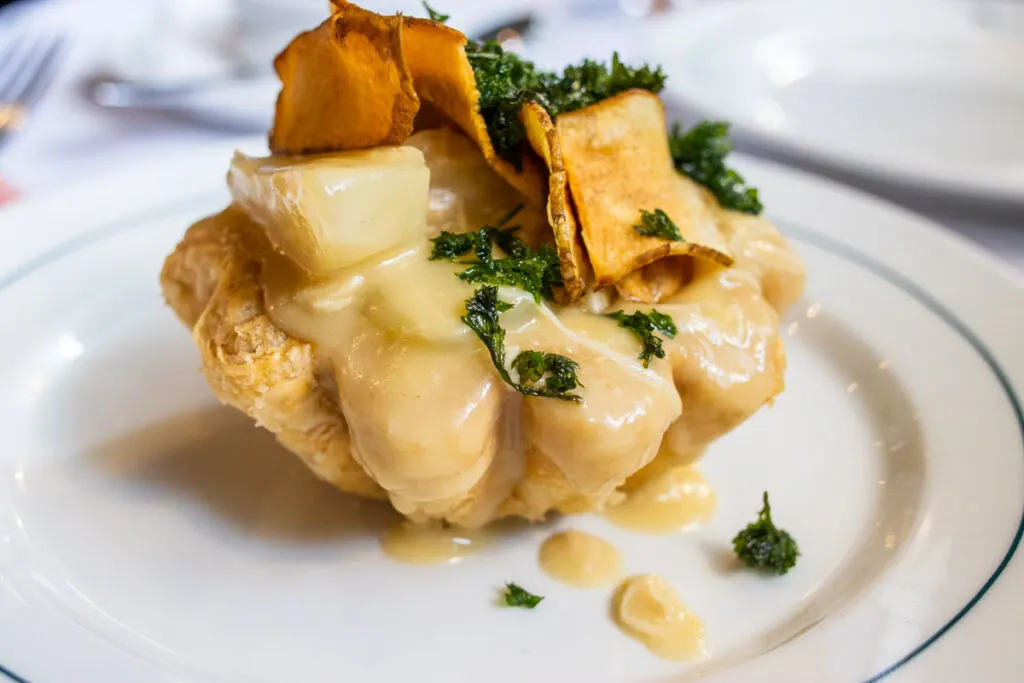
Unlike French Tartalettes which can be either sweet or savory, Danish Tarteletter are traditionally filled with savory items like shrimp and meatballs. Denmark’s most traditional Tartelette has a mix of both chicken and white asparagus.
Ironically, Tarteletter are especially popular during the Christmas holiday when white asparagus isn’t in season. Since most Danish supermarkets sell canned white asparagus as well as Tarteletter shells, home cooks can create the Danish food favorite any time of year including December. Phew!
Where We Ate Tarteletter
Schønnemann
4. Fiskefrikadeller (Fish Meatballs)
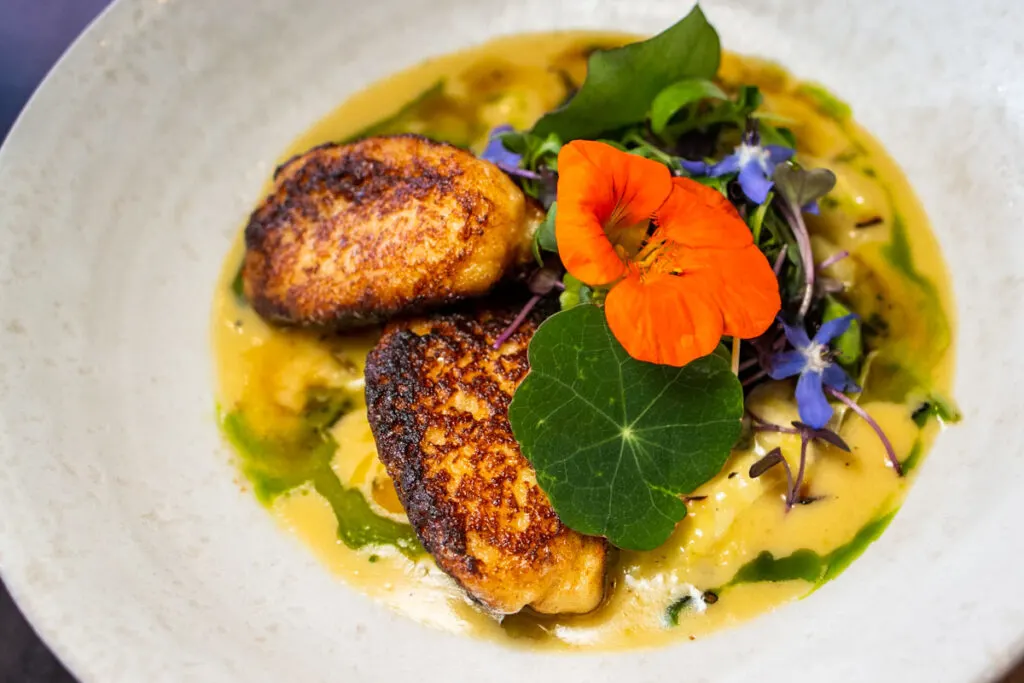
Denmark isn’t the only country to transform fish into meatballs and cakes. After eating fried fish patties as far away as Asia and as close as Norway, we’re pleased to report that Danish Fiskefrikadeller are as good as any fish cakes we’ve eaten around the world and better than most.
Cod is the most common fish used in Fiskefrikadeller which makes sense since the cold water fish swims in Denmark’s frigid waters. Other typical fish in Denmark’s Fiskefrikadeller recipe include haddock and hake.
In other words, there’s more than one fish in the sea for cooks who want to make Fiskefrikadeller as well as for pescetarians or general fish-o-files who want to eat them.
Where We Ate Fiskefrikadeller
Aamanns 1921
5. Rød Pølser (Red Sausages) – Danish Hot Dogs
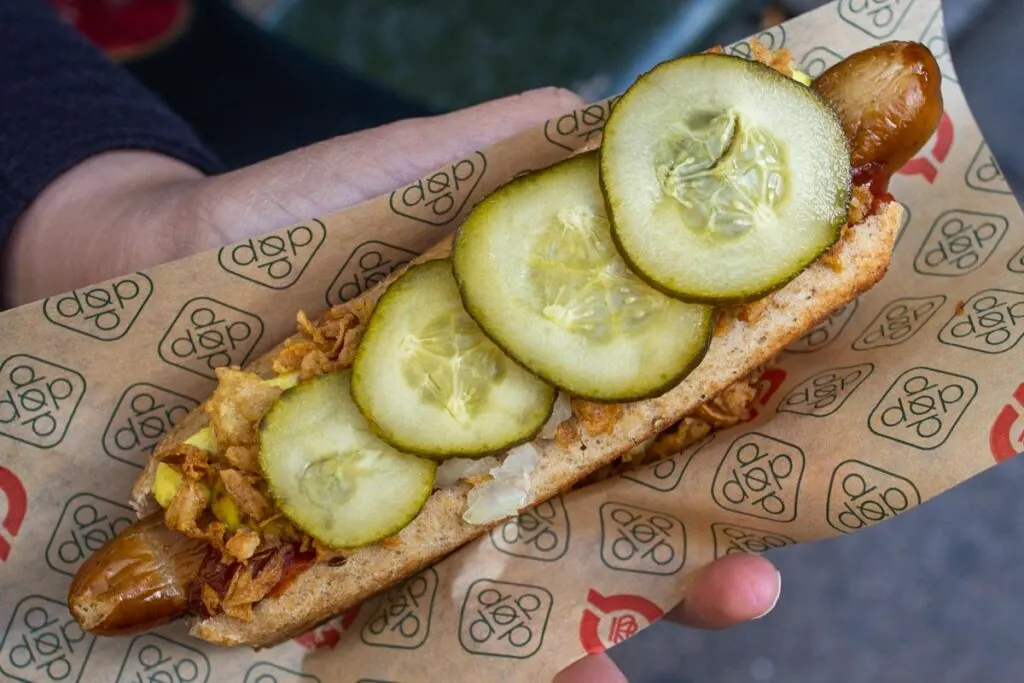
Hot Dogs aren’t unique to Denmark.
We’ve eaten Hot Dogs in American cities like Buffalo, Chicago and New York as well as in Nordic cities like Oslo and Stockholm. We can now add Copenhagen to this auspicious list now that we’ve eaten the wonderful Danish food favorite called Rød Pølse at both a gourmet pølsevogn (i.e. sausage wagon) and a 7-Eleven located right by our Copenhagen hotel.
Discover more great hot dogs around the world.
Although Danes have been stuffing ‘red’ sausages inside buns for a century, toppings keep Rød Pølser from being boring. Popular toppings include onion (both fried and raw), mustard, ketchup, remoulade and sliced pickles. We piled all of these ingredients on top of our first Rød Pølser and then did it again with our second. We’re nothing if not adventurous creatures of habit with a shared passion for street food.
Where We Ate Rød Pølse
Den Økologiske Pølsemand (DØP) and 7-Eleven
6. Syltede Sild (Pickled Herring)
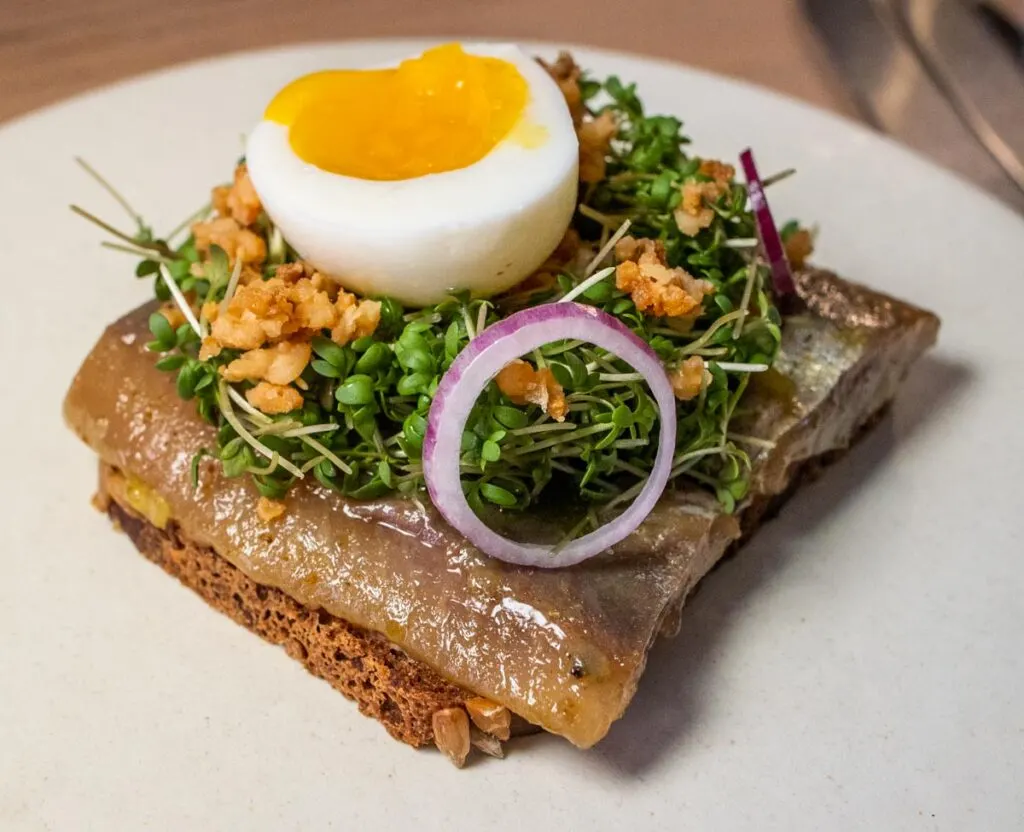
Herring has been a Danish food staple for centuries and was instrumental in the growth of Denmark’s capital city – the abundance of the bony fish in Copenhagen’s harbor even played an important role in the city’s development as a European trading center. It was only a matter of time before residents would consider Pickled Herring to be a local delicacy.
Being descendants of Eastern European immigrants, we have history with Pickled Herring too. That being said, we approached sickly sweet creamed herrings, served at family gatherings when we were kids, with dread. However, the Danes serve Herring in such a variety of preparations that it was impossible for us not to find Herring varieties that we could enjoy.
After eating a delightful Pickled Herring Smørrebrød at Aamanns 1921, we later discovered that Schønnemann serves the local fish at least 12 different ways including pickled, spiced in curry or mustard and fried. At the end of the day, our favorite way is simple – pickled and served on a Smørrebrød.
Where We Ate Syltede Sild
Aamanns 1921
7. Østers (Oysters)
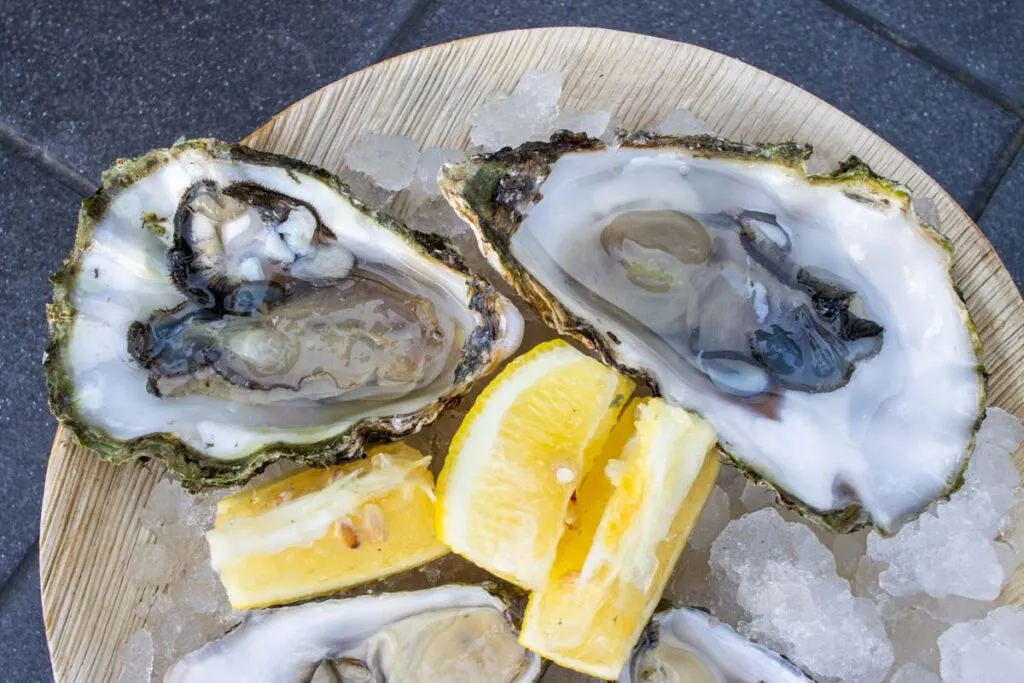
Considering that Denmark has coasts along both the North and Baltic Seas, oysters should be ubiquitous and popular. And indeed they are both.
In fact, the Danes have been eating oysters for millenia. Now, with oysters going global, Danes can eat a variety of locally raised French, North American and Danish bivalves.
Savvy oyster eaters know to stop by the city’s Torvehallerne central market and grab a few local oysters and a pint of beer. The duo is an excellent aperitivo combination best enjoyed before a traditional Danish dinner.
Where We Ate Østers
Den Grønne Kutter at Torvehallerne
8. Rugbrød (Dark Rye Bread)
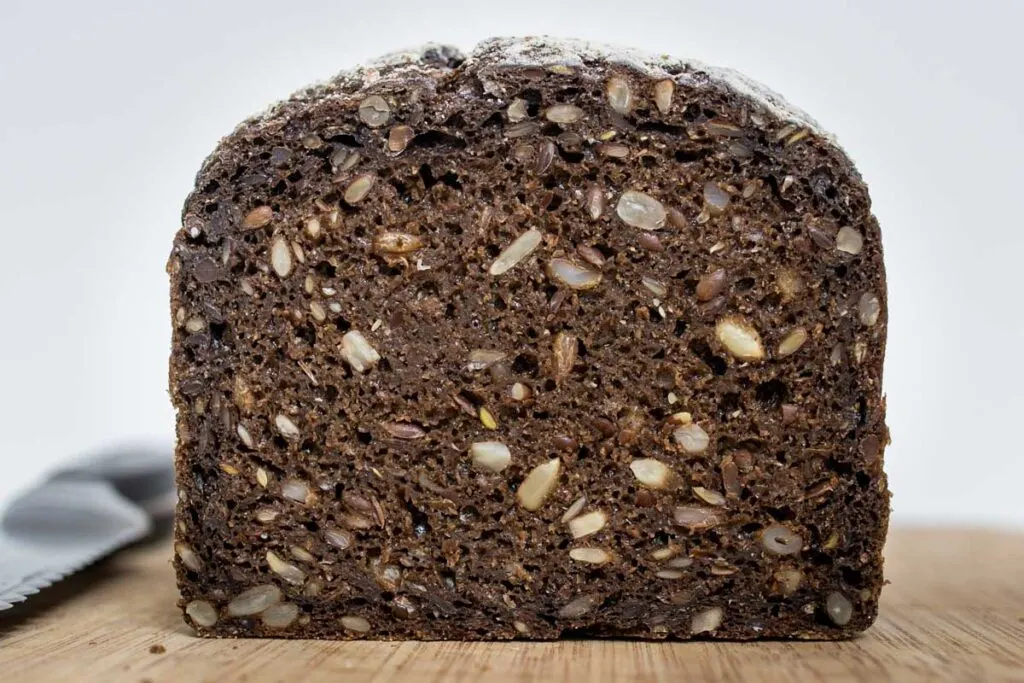
Rugbrød most likely gained popularity in Denmark to due to the fact that rye grains grow much better in colder climates. But it’s more than a Danish bread staple. The dark, dense, multi-grain Danish rye bread is the typical base for Smørrebrød.
In America, particularly in east coast cities like New York, rye bread is more of a soft sandwich loaf with only about 30% rye flour. Denmark’s Rugbrød contains all dark rye flour along with other whole grains like oats, linseed and pumpkin seed. In other words, it’s one hearty bread.
Rugbrød can stay fresh for up to a week at room temperature and, in addition to its role in Smørrebrød, makes an excellent base for other toppings like cheese and smoked salmon. If, like us, you can’t find a decent bagel in your town, Rugbrød makes an excellent substitute when you need a ‘platform’ to hold some cream cheese and smoked fish.
Where We Ate Rugbrød
Most Copenhagen Restaurants and Hart Bageri
9. Kartofler (Potatoes)
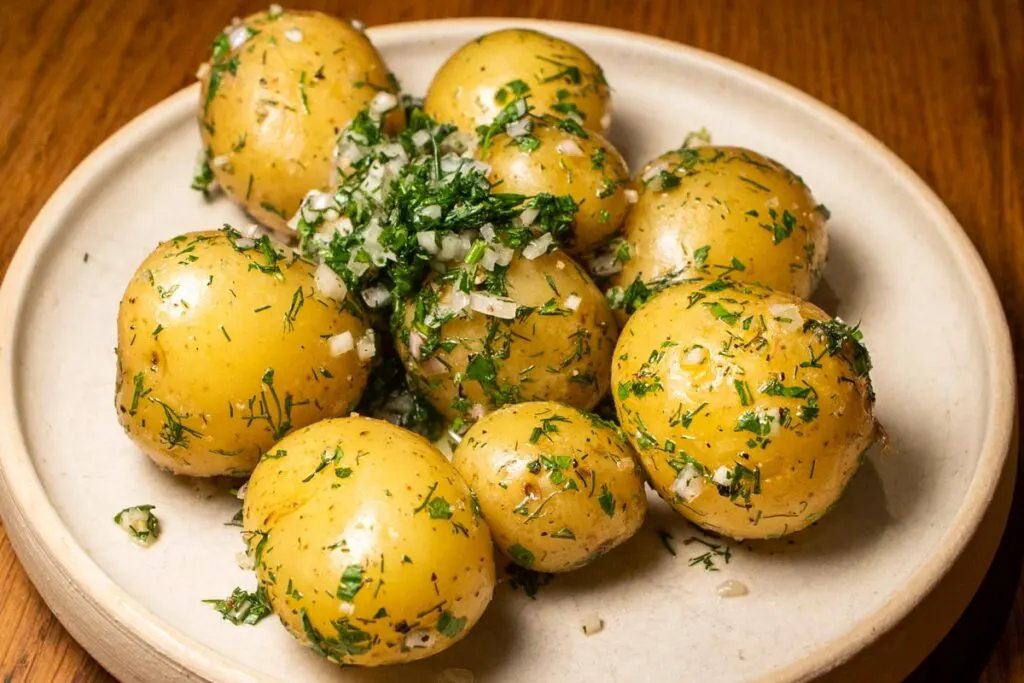
Potatoes are a bit of an anomaly in Denmark.
Danes have been eating the starchy vegetable for centuries, firmly classifying Kartoffel as a traditional Danish food. The country even has a dedicated potato museum. However, since it’s a hyper-local product grown on farms throughout Denmark, potatoes also have a place in the New Nordic food movement.
Once a food staple most notable for being both cheap and filling, potatoes have forged a place on modern Danish menus and at local hamburger joints. Accordingly, Danes eat a lot potatoes in all shapes and forms – more than 150 pounds per person each year. Danes even drink potatoes when they imbibe Aquavit.
Where We Ate Kartofler
Restaurant Barr
10. Grød (Porridge)
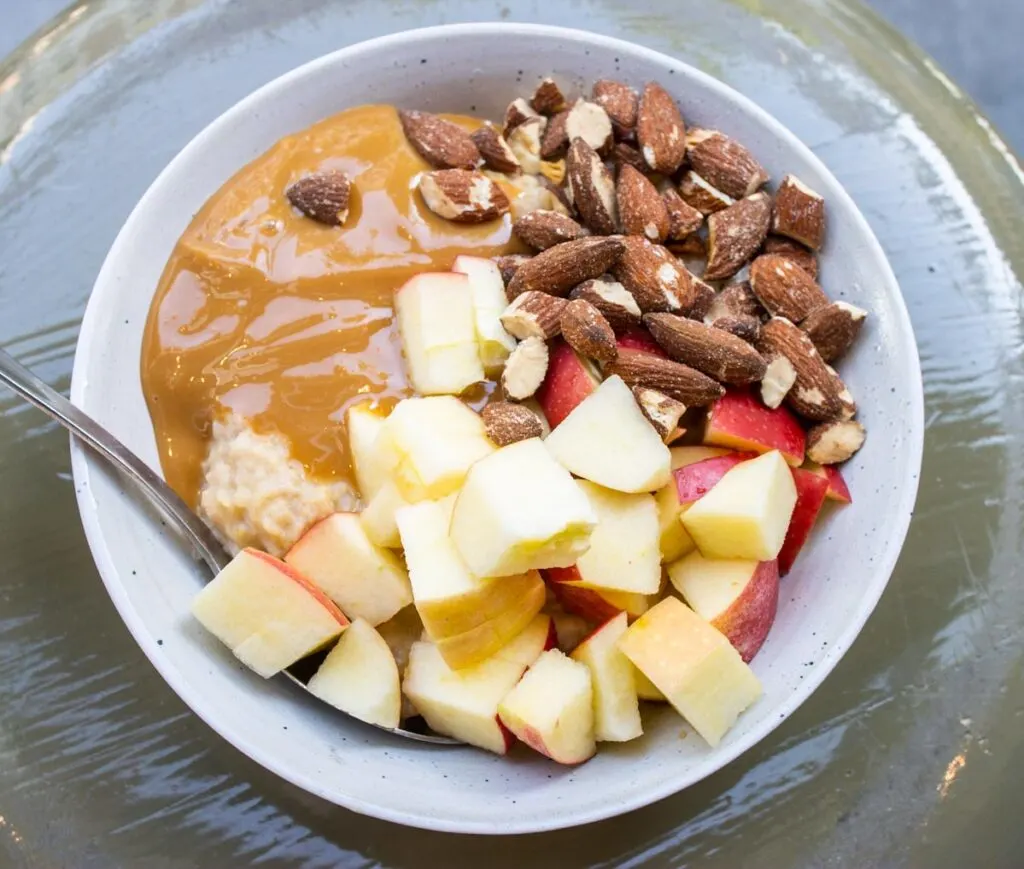
Leave your impressions behind when you eat Grød in Denmark. That’s what we did when we ordered a bowl of the popular Danish breakfast staple. Just one bite blew our porridge impressions to smithereens.
Nothing like instant oatmeal eaten in America or the Gruel that Dickens’ Oliver Twist famously requested “more” of without success, porridge in Denmark is both rich and satisfying. Truth be told, it doesn’t hurt when bowls of steel cut oats come topped with items like sliced apples, protein-filled nuts and caramel sauce.
Where We Ate Grød
Grød
11. Frikadeller (Meatballs)
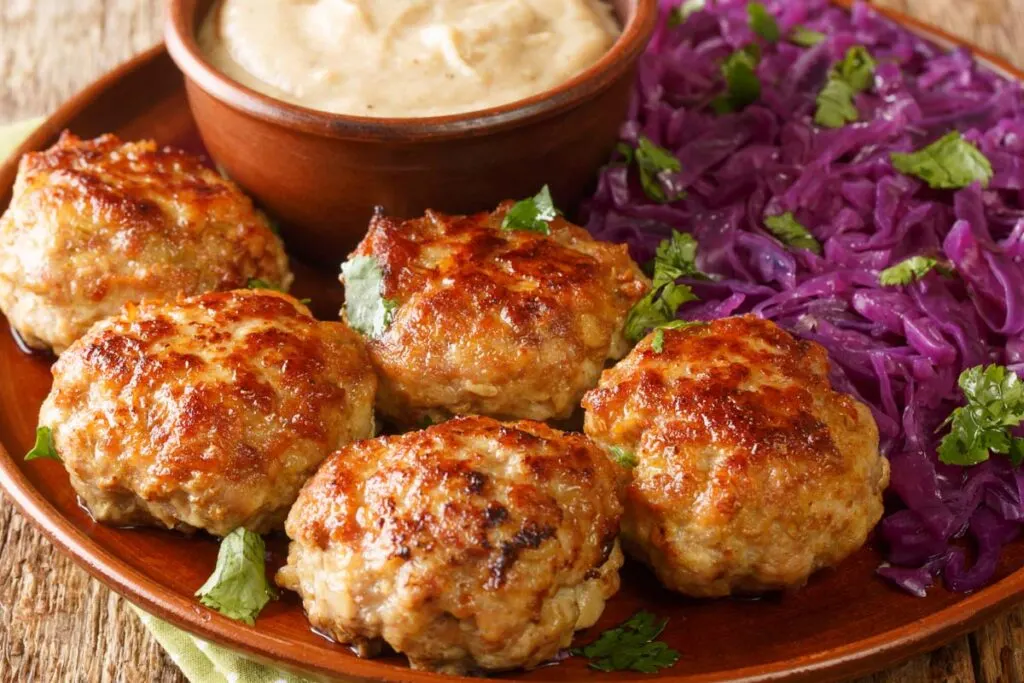
Frikadeller are Denmark’s answer to Köttbullar (Swedish meatballs) and Fleischklößchen (German meatballs) both of which we’ve eaten in their homelands. In Denmark, cooks make meatballs with either beef or pork and sometimes both.
Make no mistake – these are multi-purpose meatballs. Danish people eat Frikadeller with Kartofler and on top of Smørrebrød. Since we chose to eat fishy Fiskefrikadeller instead of meaty Frikadeller, this Danish food favorite is high on our eating list when we return to Copenhagen
12. Stegt Flæsk Med Persillesovs (Roast Pork With Parsley Sauce)
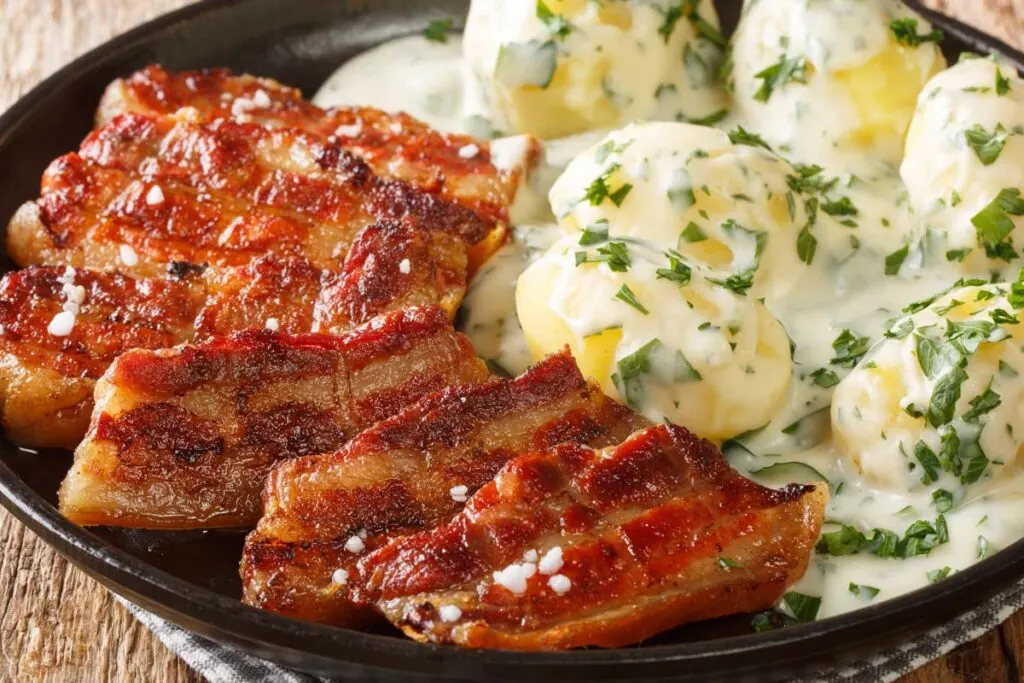
Stegt Flæsk Med Persillesovs became an instant Danish food classic when the pork dish received the most votes in a 2014 contest to find Denmark’s national dish. When you think about it, the choice was a no brainer since it’s practically impossible not to love the dish’s two main ingredients – crispy pork belly and potatoes.
The name Stegt Flæsk Med Persillesovs literally translates to roast pork with garlic sauce. No flash in the frying pan, it’s been a beloved Danish dish for more than a century. We can’t wait to try Stegt Flæsk Med Persillesovs when we return to Copenhagen because, to nobody’s surprise, we love crispy pork belly and potatoes too.
Danish Desserts and Pastries
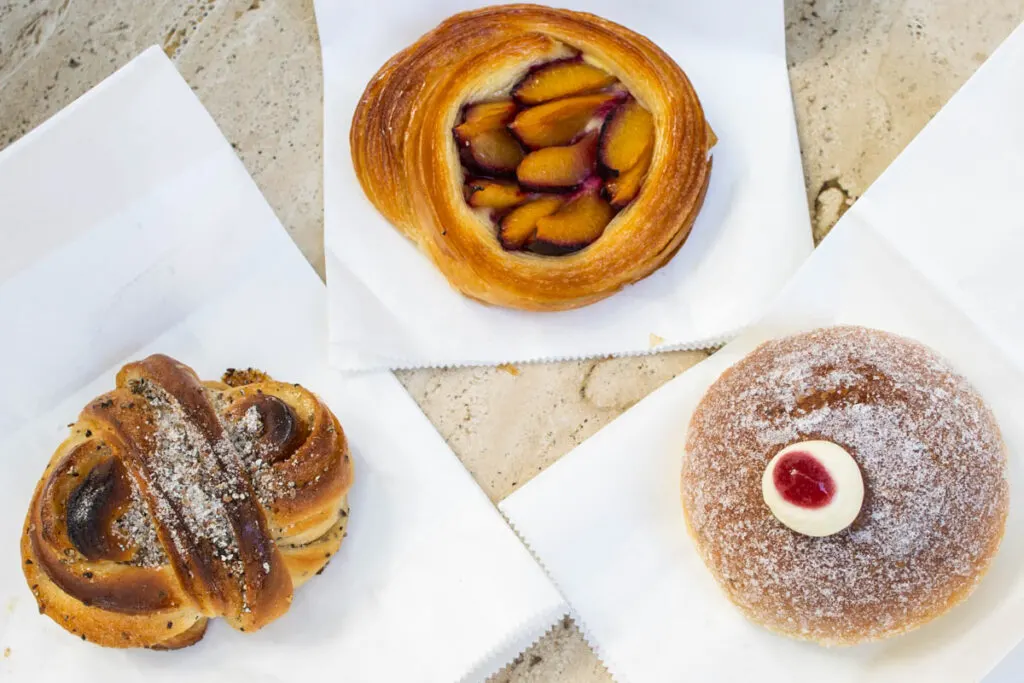
Denmark isn’t just one of the world’s happiest countries. It’s also one of the sweetest thanks to the country’s plethora of desserts and pastries available at bakeries and restaurants throughout the land.
In the 19th century, Danish bakers got their original inspiration for layered pastry called wienerbrød from Austrian bakers. If you’re not familiar with wienerbrød, they’re the pastries called danishes outside of Denmark. However, today’s Danish bakers aren’t just copying Austrian bakers – they’ve taken the Viennese pastry concept to new and exciting levels. And don’t even get us stared about Danish morning buns.
Discover our favorite Copenhagen bakeries.
After eating A LOT of Danish pastries and desserts in Copenhagen, these are our favorites and the ones you shouldn’t miss:
13. Kanelsnegle (Cinnamon Snails)
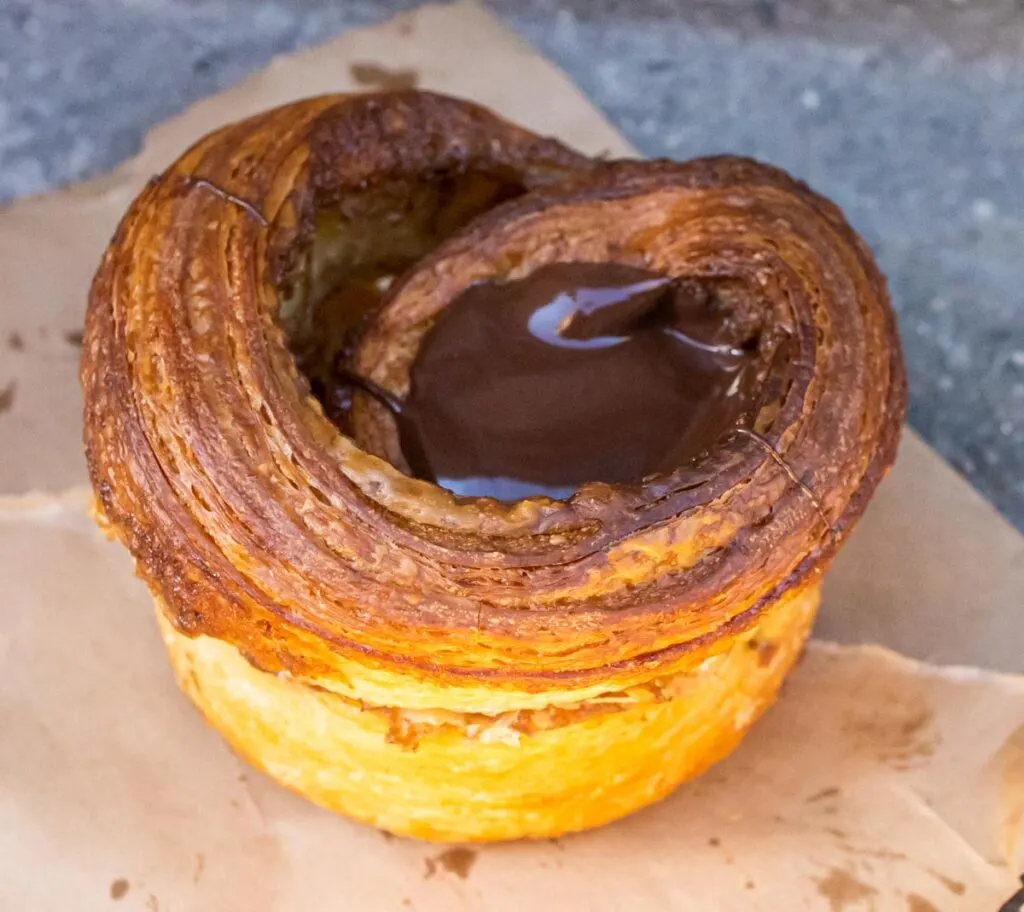
Kanelsneglelmare are easily the most popular pastry in Denmark. And why not? We also love starting our day with flaky, buttery, sweet ‘cinnamon snails’ both in Copenhagen and at home in Portugal. In a fortuitous twist of fate, we live around the corner from a Copenhagen Coffee Lab in Lisbon.
Discover more cinnamon buns around the world.
To bake Kanelsnegle, Danish bakers use a special process in which they roll buttery, layered, yeasted pastry dough before cutting the dough into thick discs. They occasionally add bonus bits like chocolate and cardamom in addition to the Kanelsnegle’s more typical sugary glaze.
Danes traditionally ate Kanelsnegle on Wednesdays and called them Onsdagssnegle, i.e. Wednesday snails. Perhaps modern Kanelsnegle should be called Hverdagsnegle (every day snails) since Danish bakeries now sell the tasty pastries every day of the week.
Where We Ate Kanelsnegle
Meyers Bageri
14. Spandauers
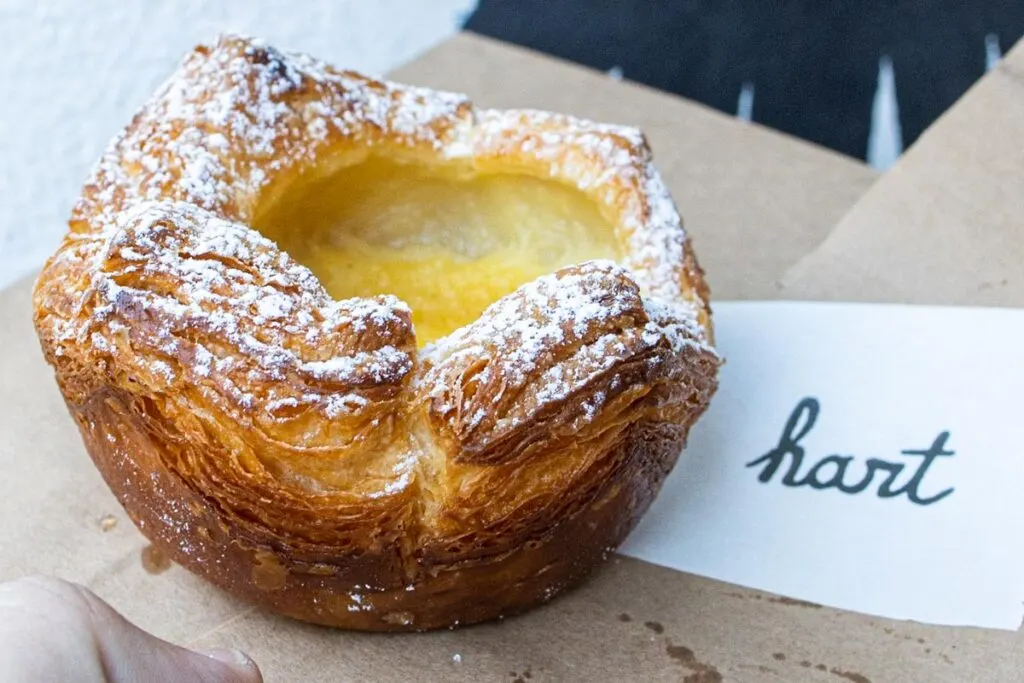
Although the Kanelsnegle is arguably the most popular Danish pastry in Denmark, it’s not the pastry that most people think of when they picture Danish ‘danishes’ in their minds. That pastry is the Spandauer.
Fun Fact
Denmark’s Spandauer pastry was named after the Spandau Prison in Berlin. This prison also inspired the 80s one-hit wonder Spandau Ballet‘s name.
The seemingly simple Spandauer is a classic wienerbrød with its flaky, laminated crust and sweet marzipan filling. Toppings like jam, fruit and cream elevate the Spandauer and make it ideal for an afternoon coffee break.
Where We Ate Spandauer
Hart Bageri and Juno the Bakery
15. Flødeboller (Cream Buns)
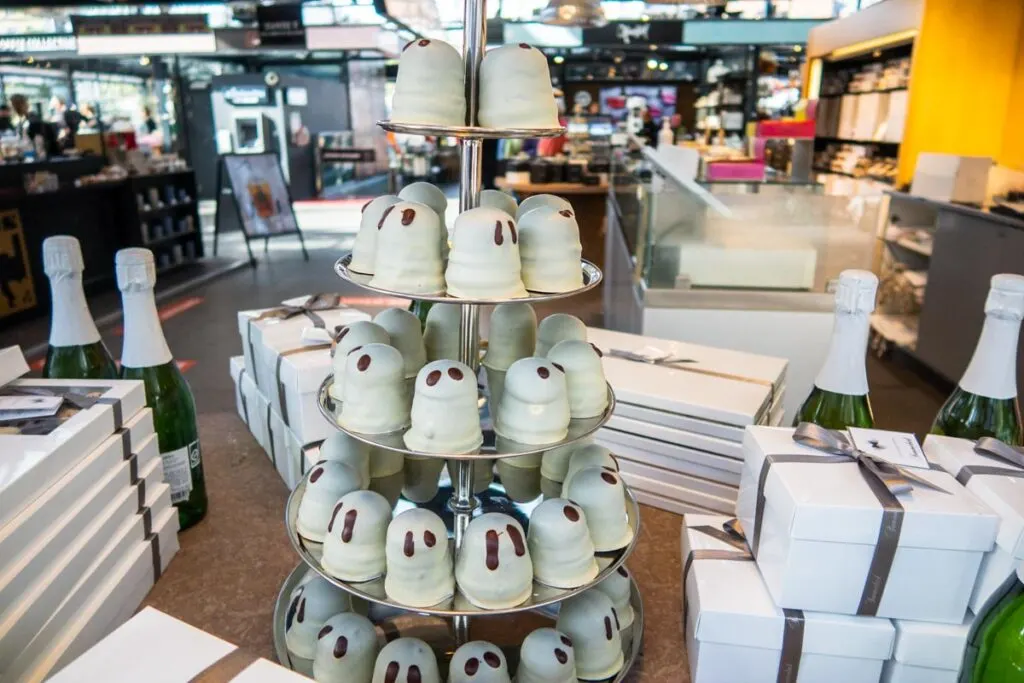
Ordering a Flødebolle in Denmark can be confusing.
Although Flødebolle literally translates to cream bun, modern Flødeboller are filled with marshmallow instead of the sweet treat’s original cream filling. Once you get past the Flødebolle’s confusing name, additional confusion can ensue due to a variety of flavors like coconut, berry, passion fruit and licorice that transcend traditional milk chocolate.
Once we got past the confusion, we kept things simple by choosing a chocolate-coated Flødebolle with a marzipan base and a vanilla marshmallow center. However, gold flecks sprinkled on top made our Flødebolle special.
Where We Ate Flødeboller
Sweet Valentine
16. Drømmekage (Dream Cake)
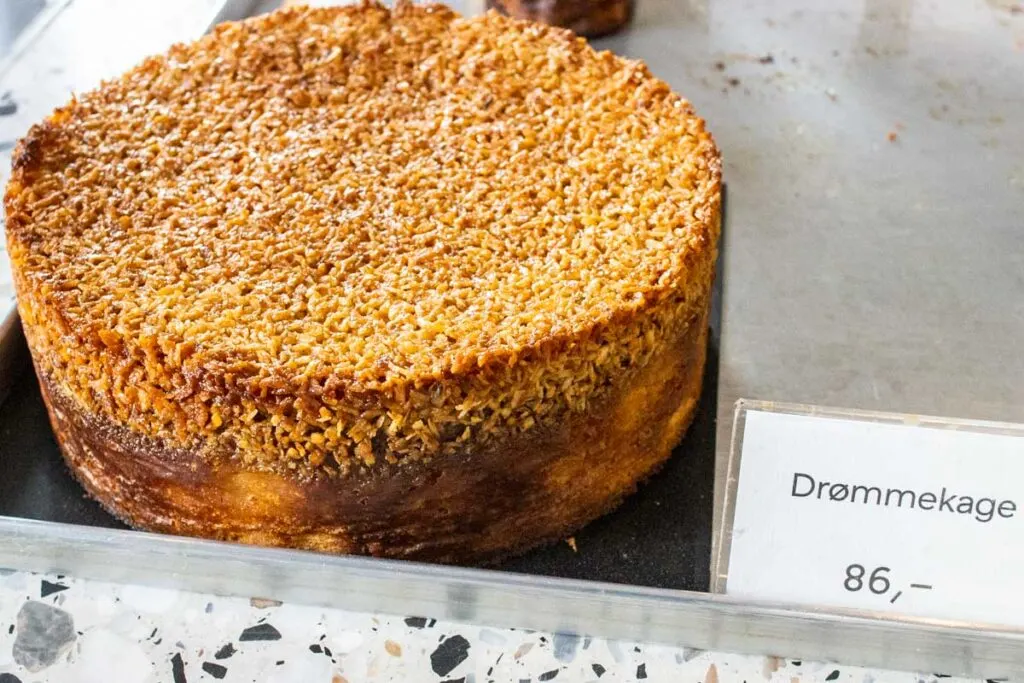
Created in tiny Hjallerup more than a century ago, Drømmekage (i.e. dream cake) first caught the country’s eye when the creator’s granddaughter, Jytte Andersen, entered the homey cake in a baking contest. Not only did her granny’s cake win the contest, but it also won the affection of an entire country which now eats Drømmekage throughout the year but especially during the Christmas season.
Today, bakeries all over Denmark bake Marie Nielsen Højgaard’s sponge cake and top it with caramelized coconut. The result is…. wait for it… dreamy.
Where We Ate Drømmekage
Andersen & Maillard
17. Sportskage (Sports Cake)
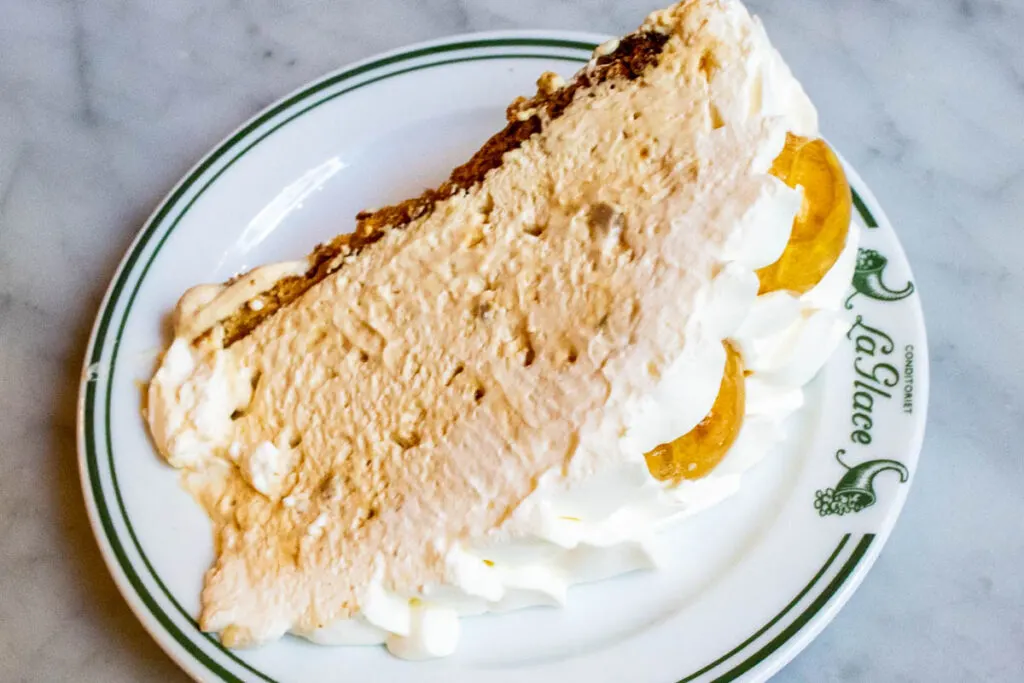
Some Danish dishes have dubious histories with no definitive backstory. The Sportskage is not one of those dishes. As we learned when we took a sweet break at Conditori La Glace, the classic cake was created by the historic bakery in 1891 as a prop for a show called Sportsmænd, i.e. Sportsmen.
To be clear there’s nothing sporty about the Sportskage except for its name. Instead, it’s a decadent Danish dessert that tops a macaron base with whipped cream, crushed nougat and caramelized choux pastry.
You may love this cake when you try it at Conditori La Glace. You may also want to visit a gym before or after you eat it.
Where We Ate Sportskage
Conditori La Glace
18. Æblekage (Apple Cake)
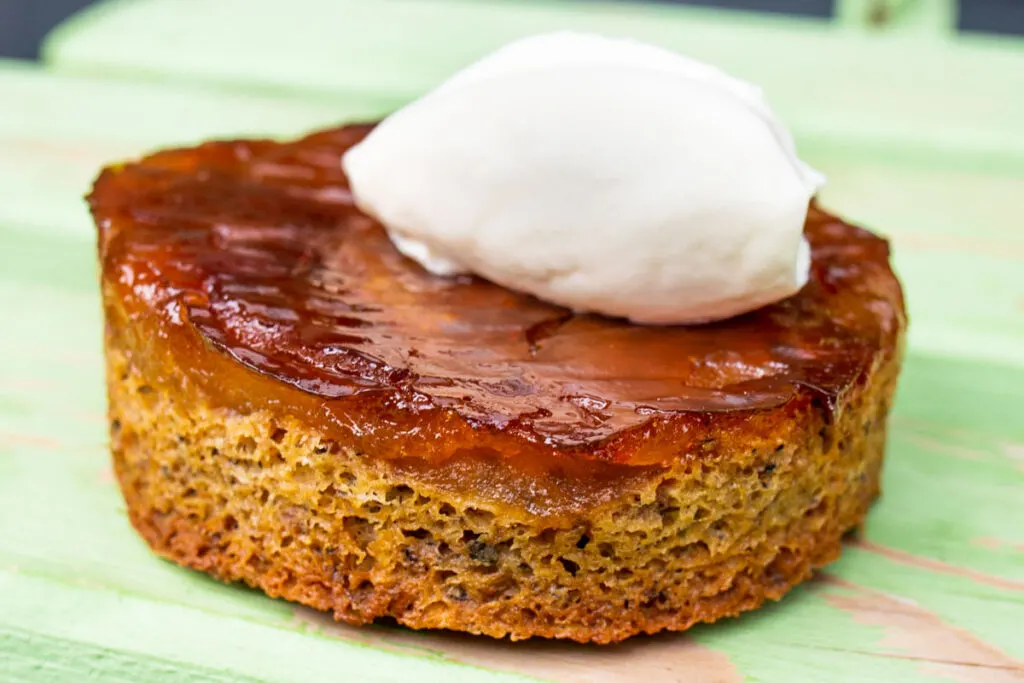
If you were to ask ten different Danes about their favorite Æblekage, you’d likely get several types of apple cake in their answers. Ironically, most will likely describe a dessert that’s more like an apple trifle than an apple cake.
That creamy Danish dessert layers apple sauce, bread crumbs, cookie crumbles, nuts and whipped cream in a clear glass vessel. It’s delicious but it’s not the only Æblekage in Denmark. Other options include homemade apple cakes topped with sliced apples and small apple tarts sold in local pastry shops.
Where We Ate Æblekage
Bageriet Benji
19. Pølsehorn (Sausage Horns)
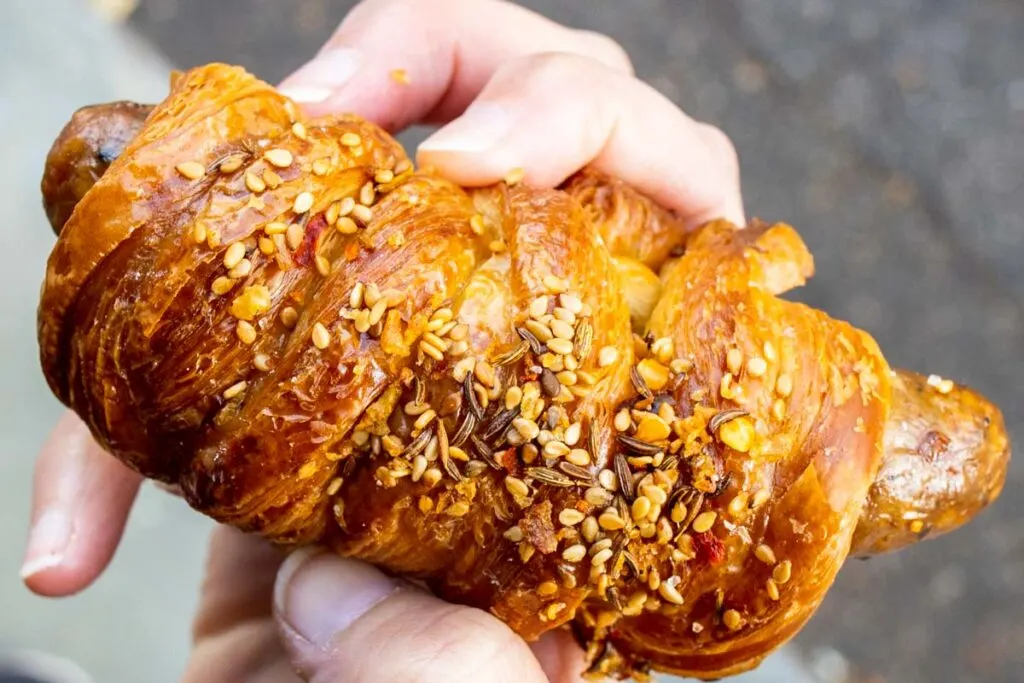
We smiled every time we saw Pølsehorn at Copenhagen bakeries.
Although Pølsehorn literally translates to sausage horn, the savory, sesame seed-topped pastry looks like a fancy pig in a blanket. And who doesn’t love the popular wedding cocktail hour appetizer?
We don’t have an answer to that rhetorical question since we adore miniature hot dogs surrounded by puff pastry. After trying a Pølsehorn on our very last morning in Copenhagen, we can now say that we also love Denmark’s bigger, and dare we say better, sausage version.
Where We Ate Pølsehorn
Hart Bageri
Danish Candy
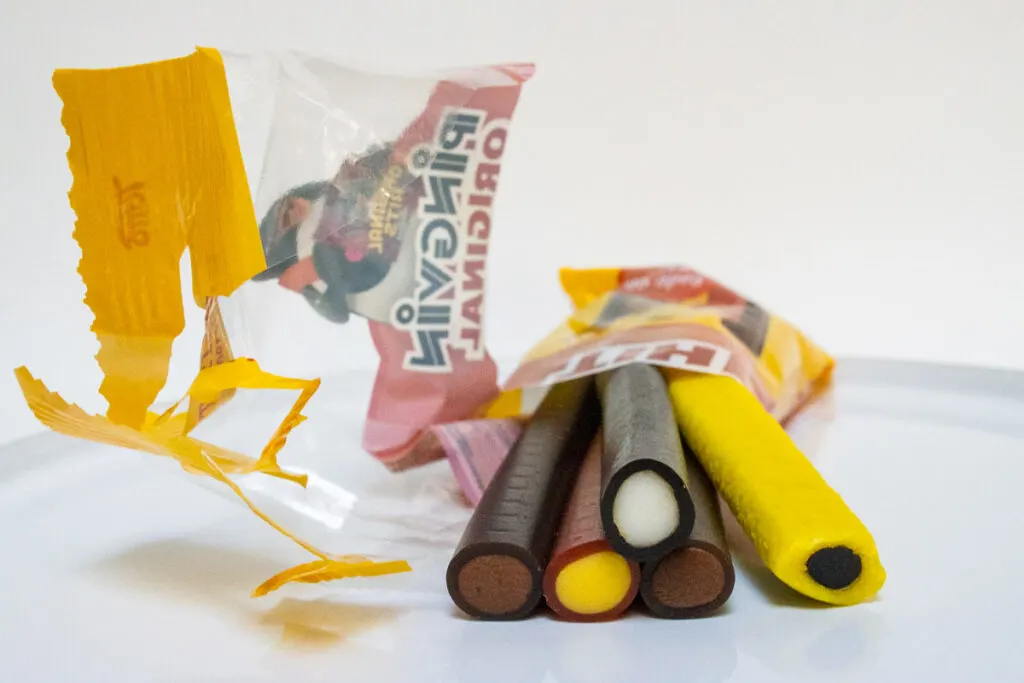
Popular Danish candies include salty licorice, candy-coated licorice and licorice gummies. However, chocolate lovers can enjoy tasty options produced in Denmark, Sweden and beyond too.
Since we love both licorice (Mindi) and chocolate (Daryl), we were intrigued every time we walked into a Danish 7-Eleven. Tempted to buy every candy on the shelf, we restrained ourselves due to health ramifications and inflated Danish prices.
However, despite these reasons, we couldn’t resist trying a few Danish candies made by Toms, a Danish candy conglomerate that dates back to 1924. These are our favorites and the ones you need to try during your visit:
20. Lakrids (Licorice)
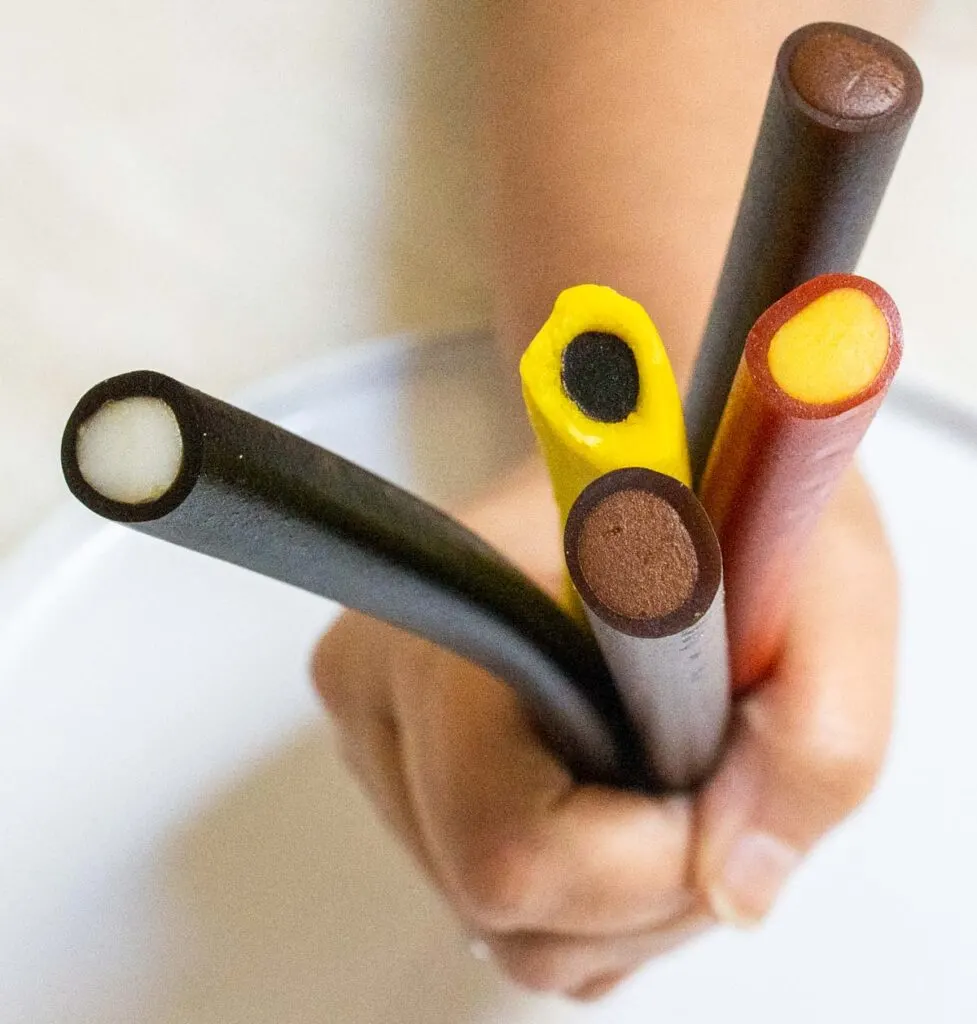
Danes are mad for licorice candy called Lakrids in Denmark.
They eat both salty licorice drops and sweet licorice gummies by the handful. They even eat licorice flavored ice cream and drink licorice infused Snaps. While many Americans can’t relate to this licorice obsession, we empathize since we’re passionate for products made with licorice root too.
Buy Lakrids from Amazon if you share our licorice passion or if you’re curious to give Danish licorice a try.
We’re especially fond of Pingvins, soft licorice rods coated with chocolate, caramel and other sweet flavors. Not only did we sample colorful Pingvins in Copenhagen, but we also bought a bag to enjoy later as an edible souvenir. You can buy a bag of Pingvins from Amazon if you want to try this licorice outside of Denmark.
Where We Bought Lakrids
7-Eleven
21. Chokolade (Chocolate)
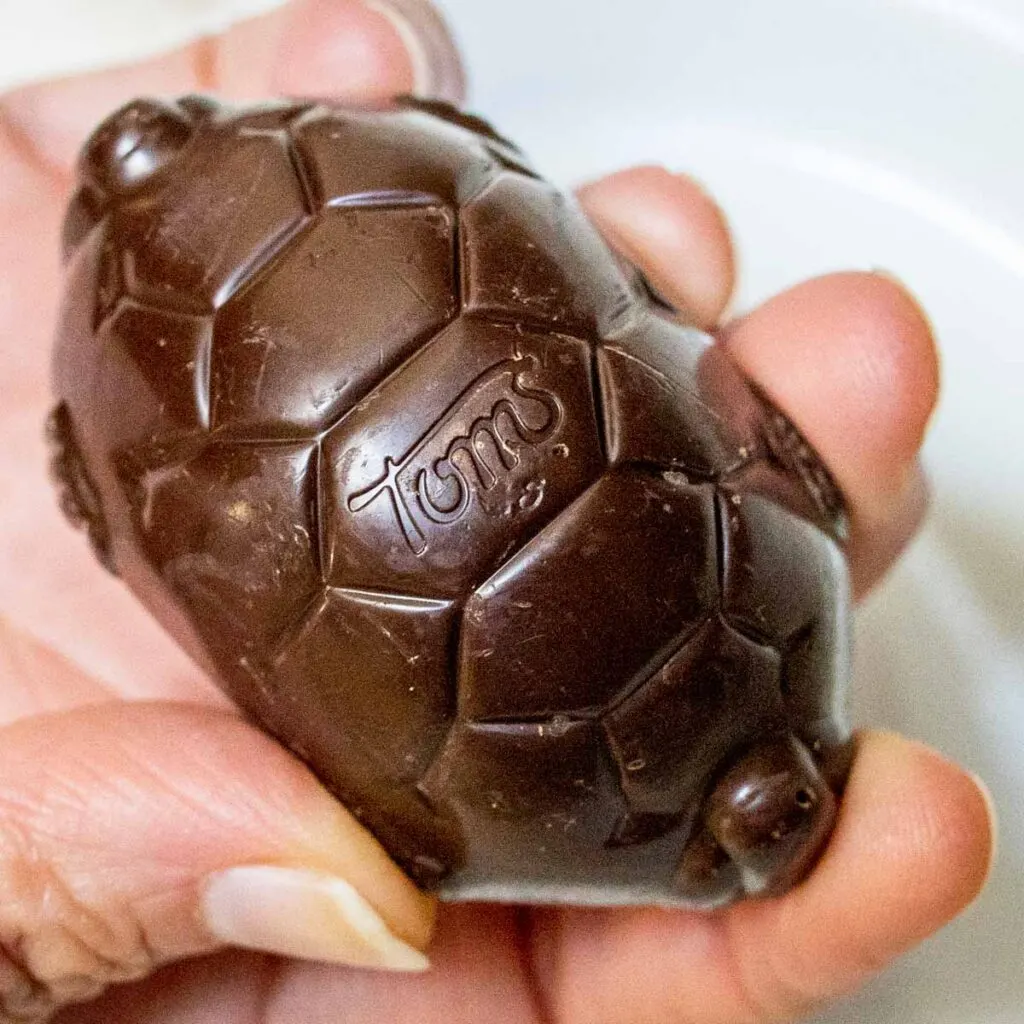
Shaped like turtles and filled with caramel and rum cream, Skilpaddes have been a Danish candy favorite since Toms started producing the milk chocolate candy in 1948. Fast forward to the present and Toms reportedly sells 41 million turtle-shaped chocolates each year.
Lured by its shiny brown and gold wrapper, we bought a couple Skilpaddes and brought them home with us to Lisbon. After unwrapping and eating both, we temporarily forgot about American candy and became Skilpadde fans too.
Where We Bought Chokolade
7-Eleven
Danish Drinks
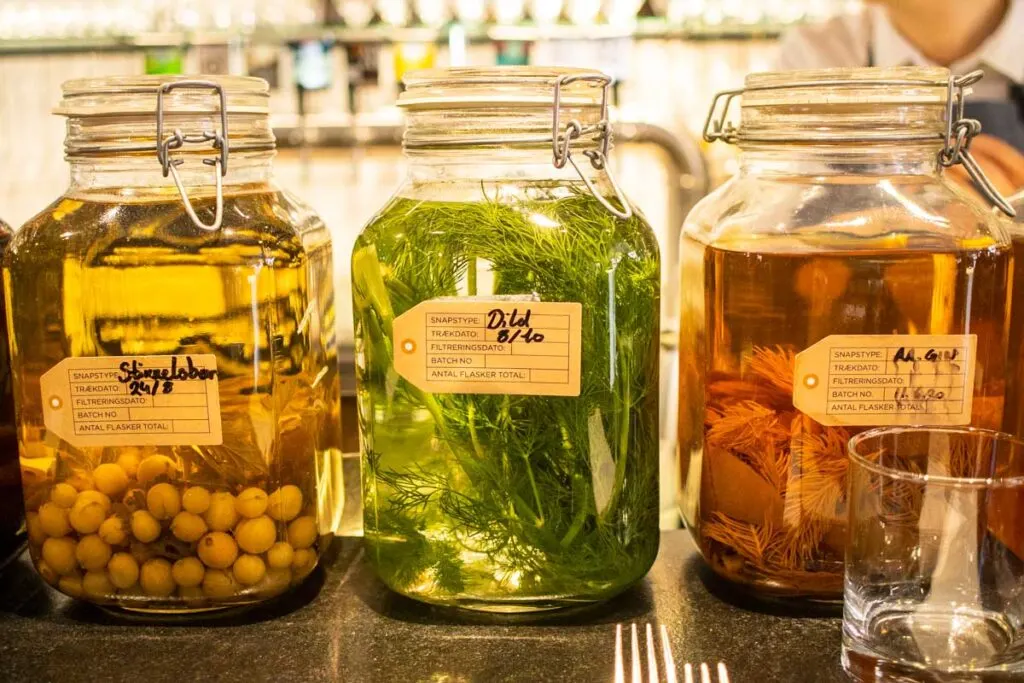
Our deep dive into Danish cuisine wasn’t limited to traditional food in Denmark. We imbibed traditional Danish drinks too!
Although Denmark has excellent tap water, the country produces various sip-worthy beverages worth ordering at restaurants and bars. After drinking almost as much as we ate, these are the Danish drinks that made us say Skål (Danish for Cheers) again and again:
22. Snaps (Distilled Fruit Brandy)
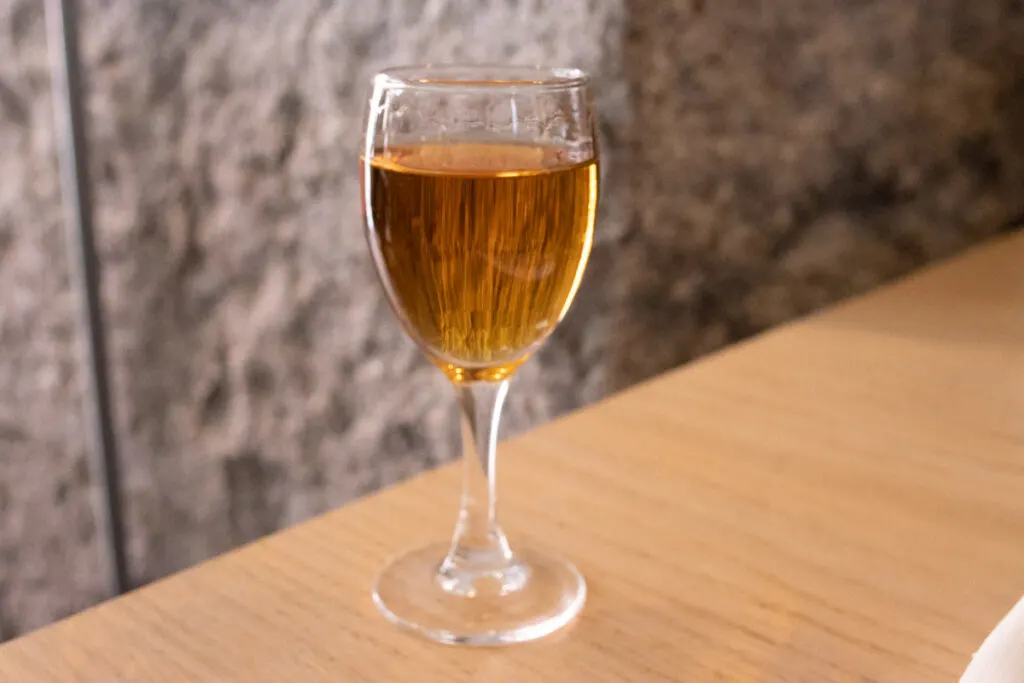
Not to be confused with your granny’s peppermint Schnapps, Snaps is a potent potable that provides a serious kick. Produced in dozens, if not hundreds, of natural flavors, the traditional Danish drink harmonizes with traditional Danish food like butter on toast.
Aquavit, Denmark’s most famous Snaps, is flavored with either dill seed or carroway. Our favorite Snaps flavor turned out to be rye bread, a preference that surprised our server. Similar to licorice, rye is apparently an acquired taste that many Americans haven’t yet acquired.
Where We Drank Snaps
Aamanns 1921 and Schønnemann
23. Øl (Danish Beer)
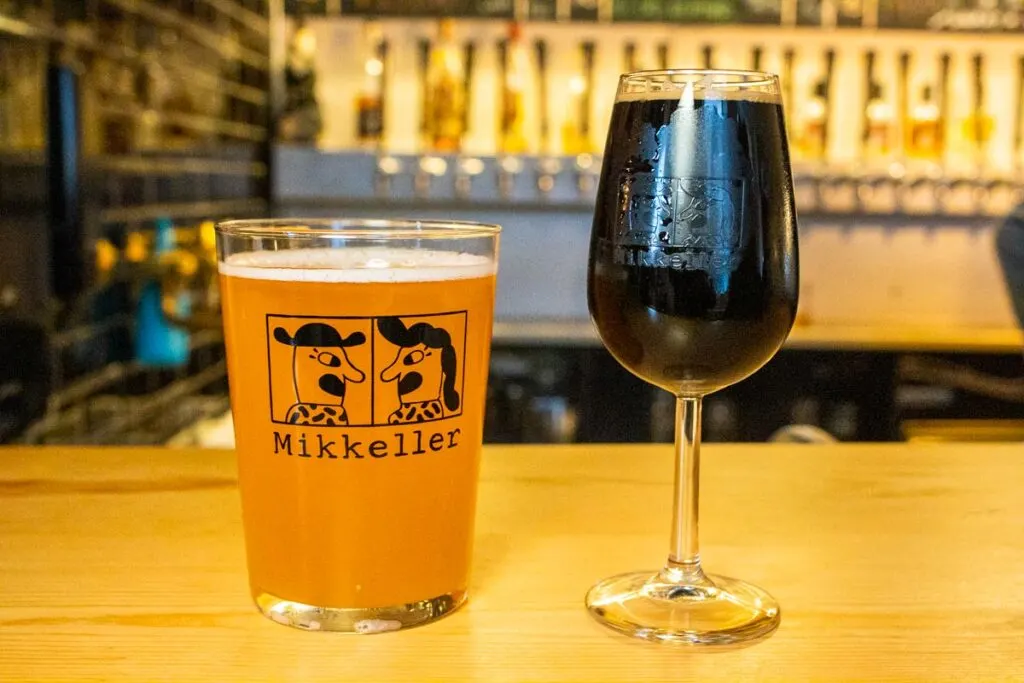
It seems like beer is all over Copenhagen for good reason – Danes produce, sell and drink a prodigious amount of lager. Not only do beer behemoths Carlsberg and Tuborg hail from Denmark as does the international craft brewer Mikkeller, but the city also has numerous bars and microbreweries that serve beer all day and into the night.
Although we were tickled by signs proclaiming Carlsberg to “probably be the best beer in the world,” we mostly drank craft beer at Copenhagen pubs and restaurants. A highlight was drinking Mikkeller at its original location. We’d previously visited a Mikkeller pub in Bucharest but there’s nothing better than drinking Mikkeller’s excellent beer at the source.
Where We Drank Øl
Aamanns 1921, Amass Fried Chicken, Mikkeller Bar, Restaurant Barr and Schønnemann
24. Faxxe Kondi (Lemon Lime Soda)
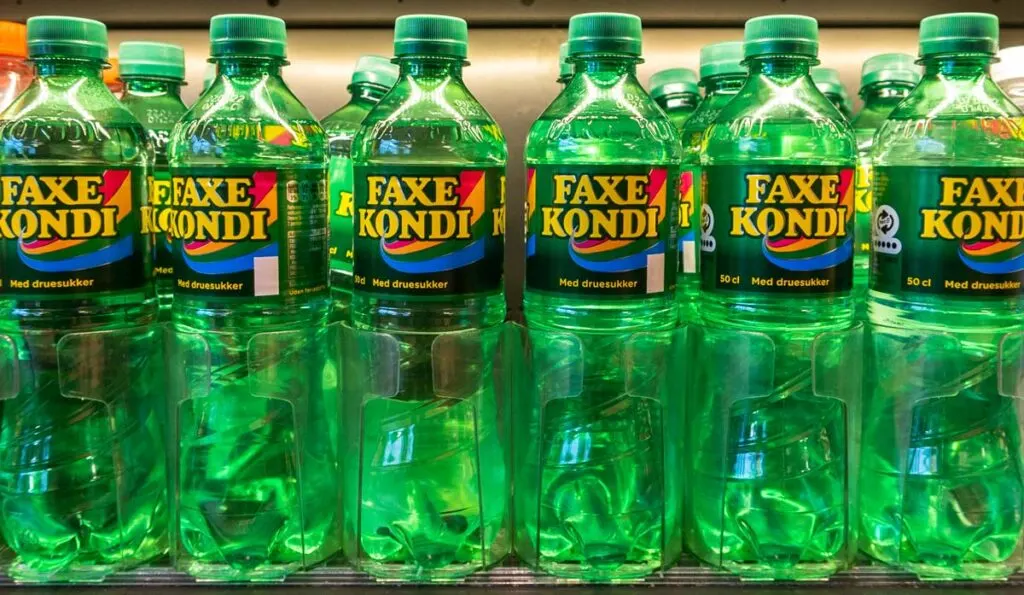
Faxe Kondi is the most popular Danish soda but it’s not the most popular soda in Denmark. That dubious honor goes to America’s Coca Cola. However, Faxe Kondi is Denmark’s most popular lemon lime soda period. Sorry Sprite and 7-Up!
This popularity is nothing new. Faxe Bryggeri, a Danish brewery now owned by Royal Unibrew, launched Faxe Kondi as a sports drink in 1971. Flavored with grape sugar in addition to glucose and sugar, the lemon lime soda doesn’t actually contain any lemons or limes.
Where We Spotted Faxxe Kondi
Copenhagen Markets and 7-Eleven
25. Kaffe (Coffee)
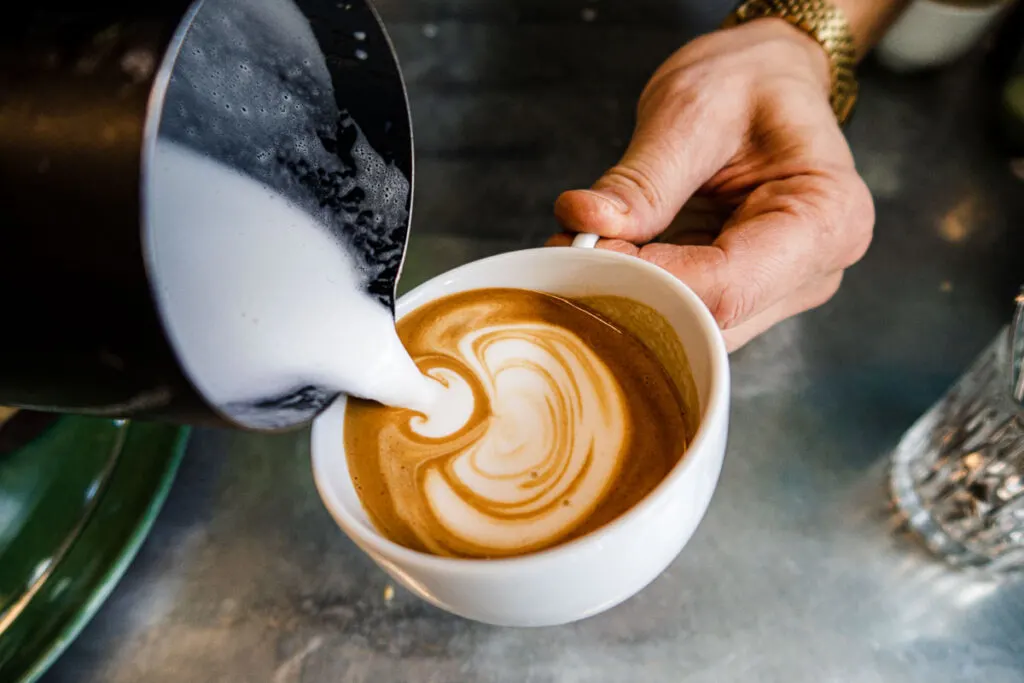
We’re not saying that coffee makes people happy BUT Danes drink a lot of coffee and they consistently rank as one of the happiest countries in the world. While it could be a coincidence, Copenhagen’s coffee scene made us happy too.
Perhaps we were so happy because of the spirit of hygge that permeates cafes throughout Copenhagen. Or maybe it was due to the quality of the city’s artisan coffee roasters. We like to think that it was both.
Where We Drank Kaffe
We visited more than a dozen specialty coffee shops and included our favorites in a comprehensive Copenhagen coffee shop guide.
Frequently Asked Questions
Denmark is famous for its open-faced Smørrebrød sandwiches.
Most traditional Danish food involves fish, meat and potatoes. Stegt flæsk, the Nordic country’s national dish, is made with crispy pork, parsley sauce and potatoes.
No. Tipping is optional in Denmark.
Snaps, beer and coffee are three popular drinks in Denmark. In fact, the Danes rank fourth in global coffee consumption.
Video Recap

About the Authors
Daryl and Mindi Hirsch
Saveur Magazine’s BEST TRAVEL BLOG award winners Daryl and Mindi Hirsch share their culinary travel experiences and recipes on the 2foodtrippers website. Since launching the site in 2012, they’ve traveled to over 40 countries in their quest to bring readers a unique taste of the world.
Original Publication Date: November 21, 2021
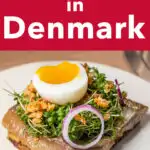
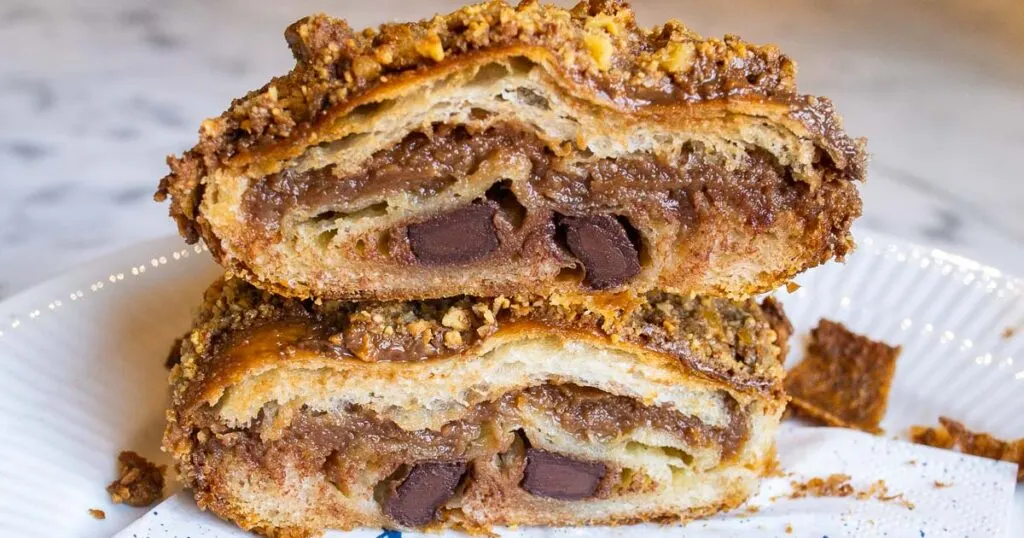
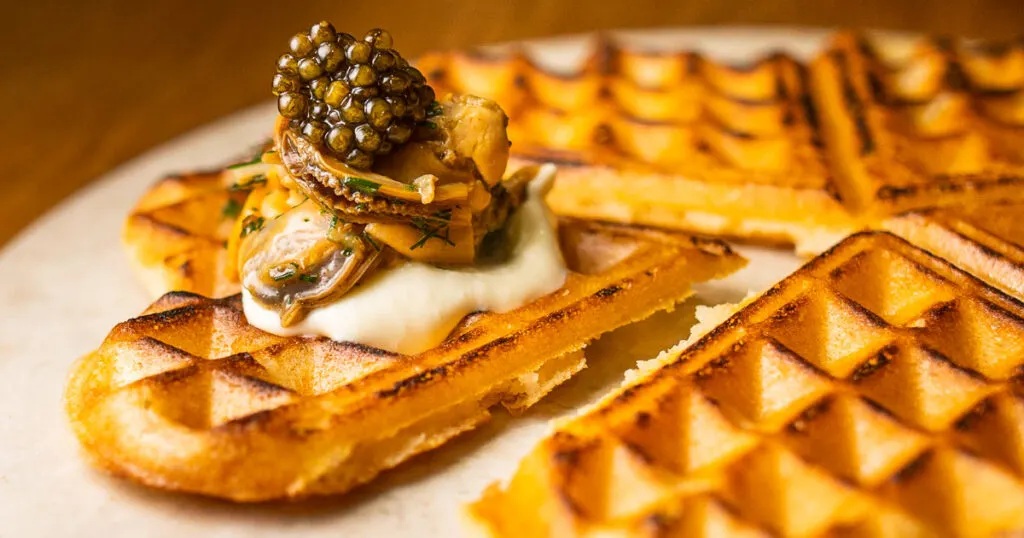
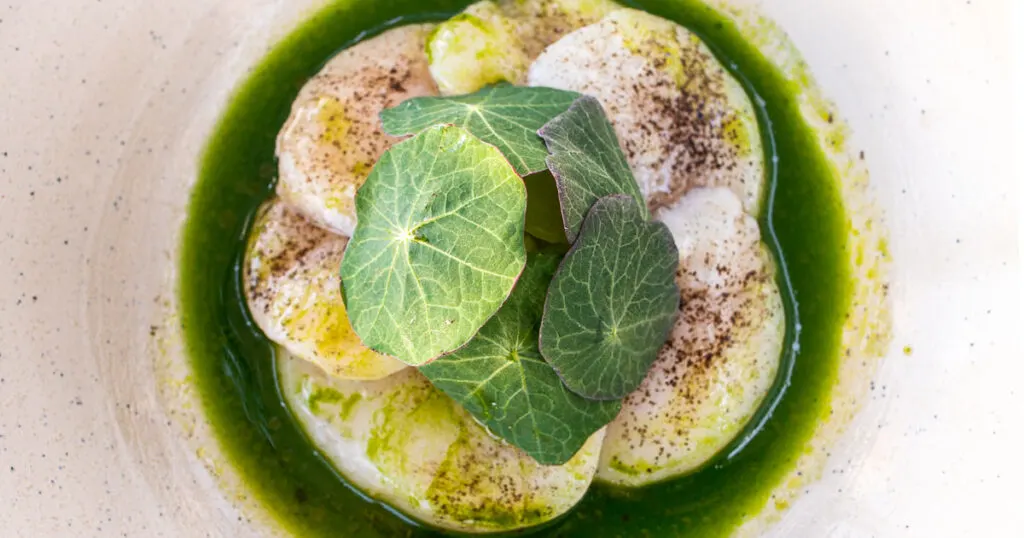
Maggie N
Saturday 15th of October 2022
Hey I don't know if you know, but some of the translations and facts on this article for the Danish foods is not correct. I'm not sure If you would like to change it or want some feedback on it but I'm here if you want it. I'm an American living in Denmark as a Danish baker and there's just a handful of things that are not quite correct. It was a nice article otherwise! Here to help if you want it!
Barbara Lewis
Thursday 9th of December 2021
Persillesovs is not a garlic sauce, but parsley sauce. And the sandwich was not topped with lovage, but pepper cress. Otherwise, pleasent reading ,🙂